This document summarizes a master's thesis that investigates how sensitive atomic field shifts are to variations in nuclear size and shape. Field shifts depend on the nuclear charge density distribution. The thesis uses realistic nuclear charge distributions from Hartree-Fock-Bogoliubov calculations and examines their effect on atomic levels and isotope shifts in heavy, lithium-like systems. It also explores extracting higher moments of the nuclear charge distribution from observed isotope shifts to gain new insights into nuclear properties.

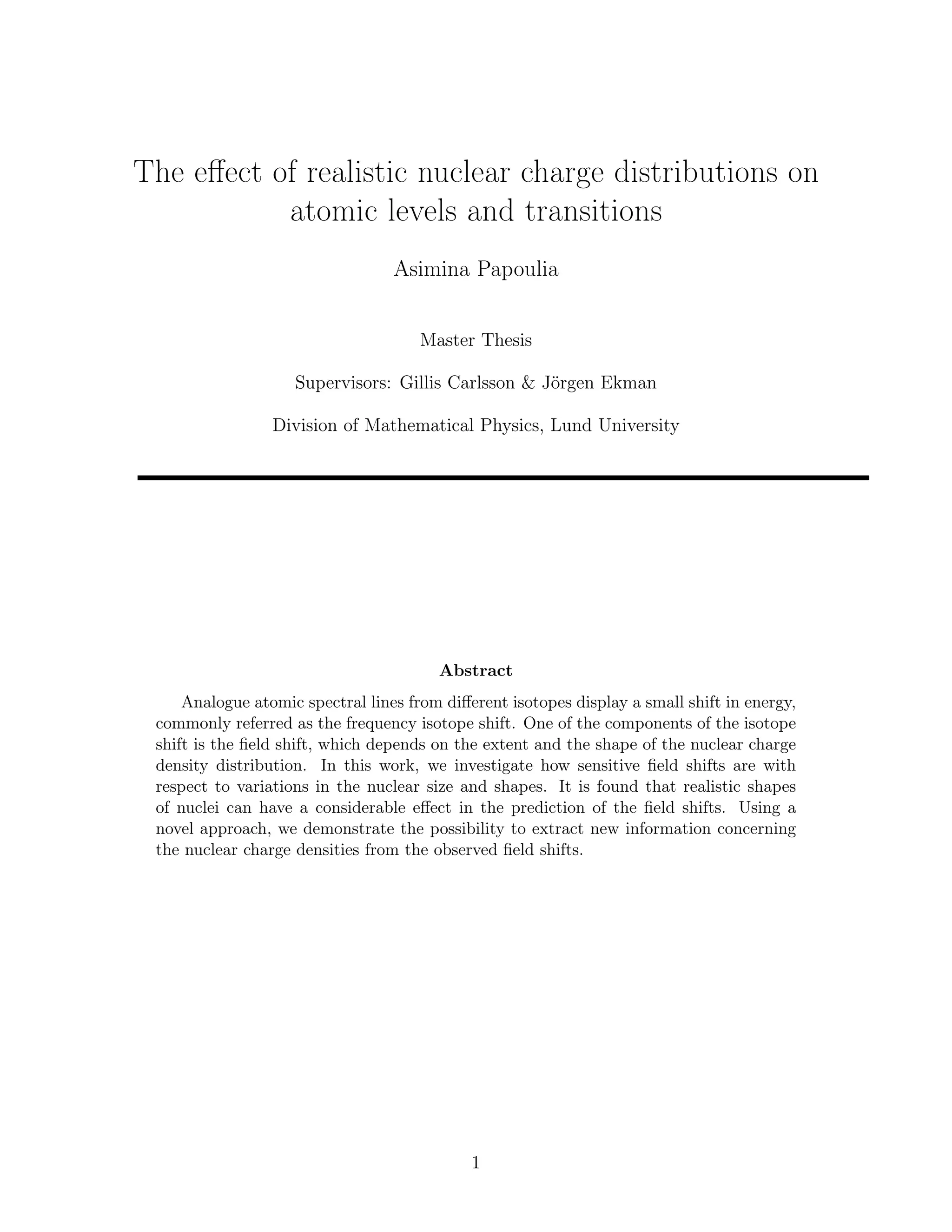
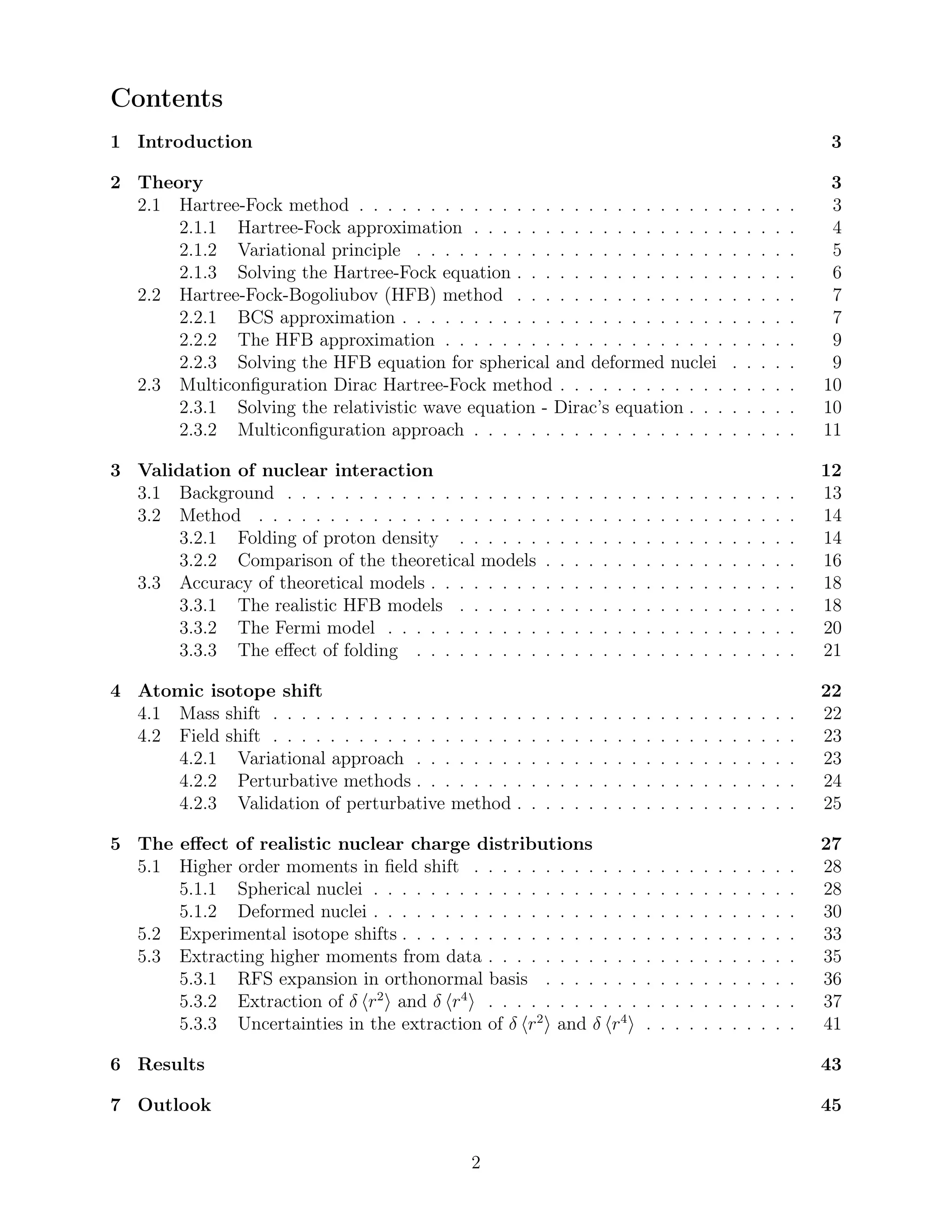
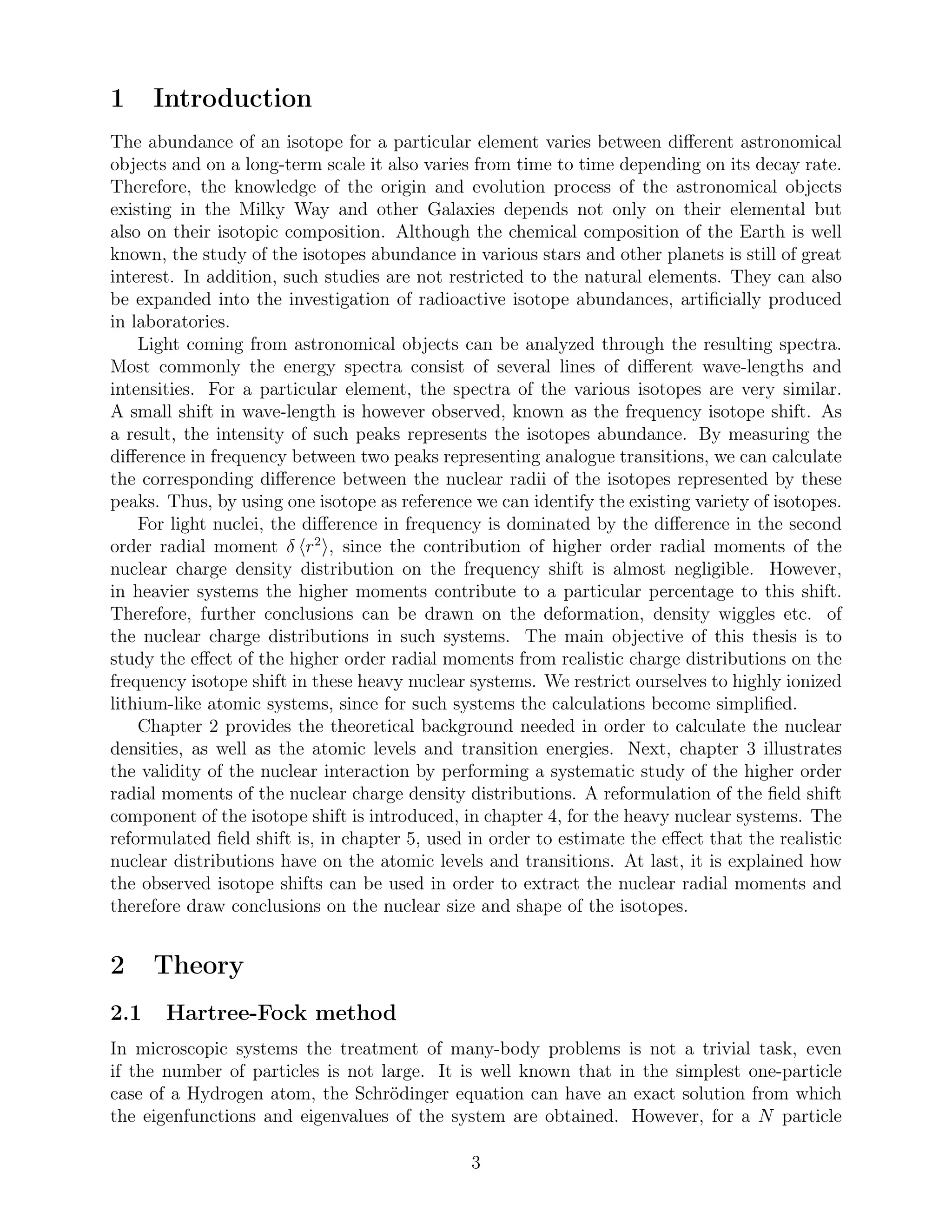
![system the Schrödinger equation is impossible to solve exactly. Therefore, methods have been
developed to make it possible to obtain an approximate solution for such systems, by reducing
the case to a one-particle problem. These approximations are called mean-field methods.
In particular, Hartree-Fock (HF) is a mean-field method widely used for the description
of many-body systems, constituting a principal tool for the description of both nuclear and
atomic states. Furthermore, the HF method constitutes the starting point for the formulation
of more sophisticated methods, like BCS and Hartree-Fock-Bogoliubov (HFB), which will be
discussed in the upcoming section 2.2.
2.1.1 Hartree-Fock approximation
The main idea of the Hartree-Fock method is based on the assumption that the potential be-
tween the numerous particles of a system can be approximated by an averaged single-particle
(mean-field) potential, so that the Hamiltonian of this many-body system is reduced to a
single-particle Hamiltonian. This procedure is known as the Hartree approximation. Initially
the Hamiltonian has the following form:
ˆH = ˆT + ˆV = −
1
2m
n
i=1
∇2
i +
1
2
n
i=j
u(ri, rj),
where the first term is the sum of the kinetic energy of all individual particles and the
second term represents the potential energy between two particles, summed up for all possible
combinations. The factor of 1
2
ensures that terms like u(r1, r2) and u(r2, r1) are taken into
account only once. The i = j restriction on the sum ensures that particles do not interact
with themselves. After the approximation the Hamiltonian above reduces to a one-particle
Hamiltonian:
ˆHHartree = −
1
2m
∇2
+ VH(r).
However, this method does not take into account the fermionic nature of particles. To
achieve this, the Hartree-Fock approximation makes the assumption that the total wave
functions of the interacting particles could take the form of a Slater determinant, so that
they obey the antisymmetry property. The linear eigenvalue problem then has the form:
ˆHHF |ψ = EHF
|ψ ,
with an additional Fock term VF included now in the potential of the total Hartree-Fock
Hamiltonian. For n-particles occupying n different orbitals {φi}i=1...n the wave function ψ
is a linear combination of products of these orbitals φi, with their coordinates {−→ri }i=1...n
permuted in all possible ways with a change of sign when the number of two-coordinate
permutations (p) is odd [3]:
ψ(−→r1 , −→r2 , ..., −→rn) =
P
(−1)p
√
n!
P[φ1(−→r1 )φ2(−→r2 )...φn(−→rn)].
The sum over P means the sum over all possible permutations of the particles coordinates
and p is the number of two-coordinate permutations required to obtain the product of orbitals
in its initial form, i.e. φ1(−→r1 )φ2(−→r2 )...φn(−→rn). Therefore, the ansatz we make has the form
4](https://image.slidesharecdn.com/f4d44770-da07-4f00-b74e-f72d1ffe325c-160216114919/75/A_Papoulia_thesis2015-5-2048.jpg)
![of a Slater determinant, which (normalized for a combination of n particles) can also be
equivalently written:
ψ(−→r1 , −→r2 , ..., −→rn) =
1
√
n!
φ1(−→r1 ) φ2(−→r1 ) . . . φn(−→r1 )
φ1(−→r2 ) φ2(−→r2 ) . . . φn(−→r2 )
...
...
...
...
φ1(−→rn) φ2(−→rn) . . . φn(−→rn)
.
For a given complete set of orthonormal orbitals {φi}i=1...n we can construct a complete
set of all possible Slater determinants, which are also orthonormal. This complete set of
orthonormal Slater determinants is said to form the Fock space [3].
2.1.2 Variational principle
To obtain the most appropriate wave function, we must choose among all possible Slater
determinants ψ the one that yields the lowest total energy. According to the variational
principle:
EHF
g.s. ≤
ψ | ˆH | ψ
ψ | ψ
,
the ground state (g.s.) energy will always be the lowest bound of a variational calculation.
For a trial wave function then the ground state energy is always larger than or ideally equal
to the exact ground state energy:
EHF
g.s. = ψ ˆHHF ψ ≥ Etrue
g.s.
Therefore, the closer the trial wave function is to the exact ground state wave function the
more representative it will be for the given system of interacting particles. The expectation
value of the Hartree-Fock Hamiltonian will be calculated by using the occupation number
representation [23]. We will then minimize the total ground state energy with respect to
all possible choices of the n existing orbitals {φi}i=1...n by applying the method of Lagrange
multipliers.
Thus, we vary the total energy with respect to an infinitesimal change in the orbitals
φi(−→r ), e.g. δE =limε→0
E[φi+εδφi]−E[φi]
ε
. Requiring that the energy is stationary with
respect to variations and putting as constraint the fact that the orbitals must be normalized,
we get:
δE = δ ψ ˆH ψ −
i
ǫi d−→r |φi|2
= 0,
which yields the Hartree-Fock equation [4]:
ˆT + VH + ˆVF φk(−→r ) = ǫkφk(−→r ),
where
VH(r1) = u(r1, r2)ρ(r2)dr2,
5](https://image.slidesharecdn.com/f4d44770-da07-4f00-b74e-f72d1ffe325c-160216114919/75/A_Papoulia_thesis2015-6-2048.jpg)
![is the Hartree potential that depends on the local particle density ρ(r2) and expresses the
potential energy of a particle at point r1 due to the interaction u(r1, r2) and ˆVF is the Fock
operator based on the Fock potential:
VF (r1, r2) = −u(r1, r2)ρ(r1, r2),
which depends on the non-local density ρ(r1, r2). Hence, the Hartree term can be written as
a potential which is common for all particles, while the Fock term gives in fact rise to slightly
different potentials for each particle.
2.1.3 Solving the Hartree-Fock equation
Since both the Hartree and Fock potentials depend on the orbitals φi(−→r ), the HF equation
derived above is non-linear. Therefore, this equation can only be solved self-consistently
using the method of iterations by following the steps that are described below:
1. We start by making an initial guess for the orbitals {φi}i=1...n .
2. Particle density ρold(−→r ) and particle non-local density ρold(−→r , −→r ′
) can be calculated.
3. From the densities found in step 2 (or 6), we can calculate the potentials: VH[ρ(r)] and
VF [ρ(−→r , −→r ′
)]respectively and build the total Hamiltonian of the system.
4. Keeping VH and VF fixed, we can now solve the Hartree-Fock equation:
ˆT + VH + ˆVF φk(−→r ) = ǫkφk(−→r ),
which yields new orbitals φk(−→r ).
5. Subsequently, the new orbitals yield new densities ρnew(−→r ) and ρnew(−→r , −→r ′
) respec-
tively.
6. The new densities are used now, after some mixing with the old ones - the reason of
this mixing will be explained soon - , as a new input so that we can start again from
step 3.
We repeat the described process until convergence is reached. In other words, we continue
until the difference between the new and old density is smaller than some chosen tolerance.
The most common trick used in order to achieve convergence is to mix the densities from
the previous iteration with the new densities obtained from step 5 above. An extra step
is then added to the method. Hence, after step 4 we define (for each iteration m that is
performed) the new mixed densities as ρnew = αρ(m)
+ (1 − α)ρ(m−1)
, where α is a parameter
that determines the amount of mixing.
In order to solve the HF equation in step 4, we work in a configuration space based on
some arbitrary complete and orthogonal set of single-particle wave functions. The most
commonly used set is the harmonic oscillator (HO) wave functions. Thus, each one of
the orbitals {φi}i=1...n is written as linear combination of these HO wave functions, e.g.
6](https://image.slidesharecdn.com/f4d44770-da07-4f00-b74e-f72d1ffe325c-160216114919/75/A_Papoulia_thesis2015-7-2048.jpg)
![φ1(−→r1 ) =
N
i=1
c1
i bi(−→r1 ) where N is the number of basis functions that are used for the expan-
sion. The coefficients cj
i are then determined in such a way that the corresponding energy
has a minimum (variational principle). The HF equation is eventually transformed into a
matrix eigenvalue equation that can be solved using existing numerical methods.
2.2 Hartree-Fock-Bogoliubov (HFB) method
The procedure of solving the HF equation self-consistently for a system of particles inside a
nucleus provides us with a rather satisfactory description of the nuclear charge density distri-
bution. However, in order to be able to understand and describe phenomena experimentally
observed, like the spectral energy gap in even-even nuclei, we have to take into account the
correlations due to the short-range part of the nucleon-nucleon interaction, called pairing [16].
Thus, by enhancing the HF method we will be capable of laying out an improved description
of the nuclear charge density distributions and their properties, i.e. rms (root-mean-square)
radii and higher order radial moments.
Pairing correlations are described in the BCS method, developed by the solid-state physi-
cists Bardeen, Cooper and Schrieffer (BCS) in 1957, so that it could be applied to the theory
of superconductivity. Later, the same theory was also applied to nuclei by Bohr, Mottelson
and Pines in 1958 [13] after they realized that the effect of pair interaction was analogous
to the superconductivity in metals. Therefore, using the wave-function suggested by BCS,
whose form is demonstrated below, as ansatz (instead of the more simplified Slater determi-
nant) and vary the new wave function to find again the minimum of the energy after having
already solved HF equations leads to a more powerful approximation for the description of
nuclear many-body systems. Finally, the BCS approximation in turn, constitutes the starting
point of the formulation of the Hartree-Fock-Bogoliubov (HFB) method.
2.2.1 BCS approximation
The concept of pairing correlations implies that the motion of nucleons is disturbed by
their interactions with other nucleons. Thus, nucleons can be seen as quasi-particles (same
undisturbed particles but with different masses). Hence, in the BCS approximation the
quasi-particle formalism is used. We look for a more general product of wave functions
consisting of independently moving quasi-particles and thus, we make an ansatz different
from the Slater determinant that is used in the HF method. The most appropriate ansatz
has been proven to be the one analogous to the ground state wave function suggested by
Bardeen, Cooper and Schrieffer for determining the ground state of a superconductor. The
BCS wave function for nuclei is then illustrated in the following way:
ψBCS
o =
ν
(Uν + Vνα+
ν α+
ν ) |0 ,
where |0 is the vacuum state and V ν, Uν represent variational parameters. These parameters
are subject to the constraint V 2
ν+U2
ν = 1 due to the normalization condition, since they are
regarded as the probability that a certain HF pair state (ν, ν) is or is not occupied respectively.
Additionally, according to the variational principle these parameters are determined in such
a way that the corresponding energy has a minimum.
7](https://image.slidesharecdn.com/f4d44770-da07-4f00-b74e-f72d1ffe325c-160216114919/75/A_Papoulia_thesis2015-8-2048.jpg)
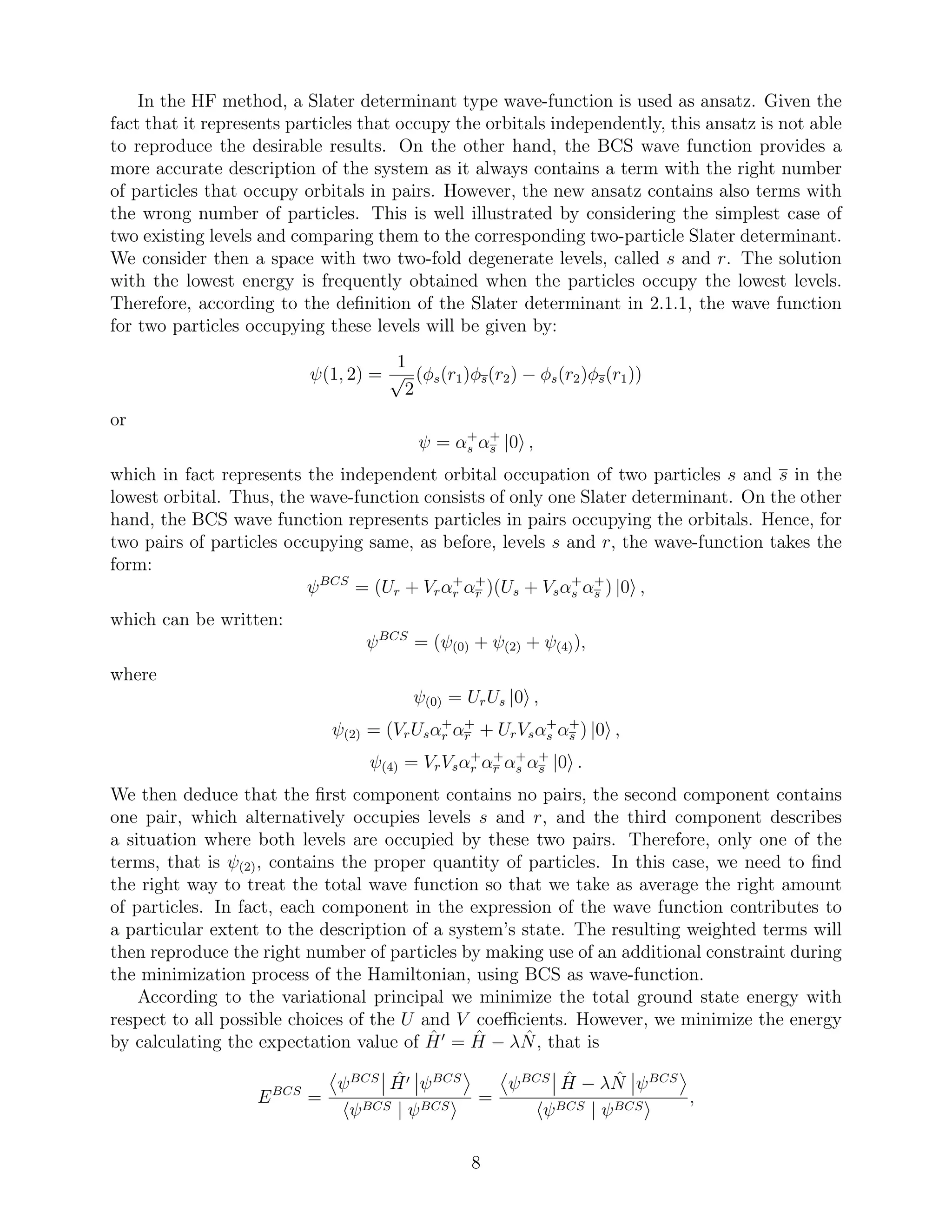
![where λ is a Lagrange multiplier and ˆN the number operator defined as:
ˆN =
ν
α+
ν αν + α+
ν αν ,
summing over all the pair states (ν, ν). Therefore, the condition that assures that the
average number of particles equals the actual number of particles, N, is represented by
N = ψBCS ˆN ψBCS
= N . Combined with the normalization condition, parameters Vν
and Uν can now be fully determined.
2.2.2 The HFB approximation
According to the previous subsection 2.2.1, the BCS wave function is used in order to provide
a more appropriate representation of nuclear states. Therefore, based on the mean-field that
was already found in the HF method we perform again the minimization process of the
energy in order to determine parameters Vν and Uν for each HF pair state (ν, ν). The
Hartree-Fock-Bogoliubov (HFB) method is similar to the BCS method. However, in HFB,
during the minimization of the Hamiltonian we minimize with respect to both the Vν and Uν
coefficients, as well as the orbitals. In this case, the mean-field is also varied.
2.2.3 Solving the HFB equation for spherical and deformed nuclei
The iterative process is also used in the new approximation, and HFB equations are solved
using the simple iterative diagonalization method with mixing of orbitals as described in
1.1.3. Hence, same mixing tricks are used in order to facilitate convergence. Moreover, the
harmonic oscillator (HO) basis is again used in the HFB method for expanding the single-
particle wave-functions of neutrons and protons for a given nuclear state. For A particles
and considering the HF-limit, the particle density is written:
ρ(−→r ) =
A
i
|φi(−→r )|
2
=
A
i=1
φ∗
nilijimi
(−→r )φnilijimi
(−→r ),
which is the sum of all individual particle densities for all A particles, with each one of
them being in a particular nljm state. Each one of the occupied orbitals {φi}i=1...A is a
linear combination of the HO wave functions. Using jj-coupling, the particle density can be
written as:
ρ(−→r ) =
JM
ρJM (r)YJM (θ, ϕ),
meaning that the particle density can finally be written as a superposition of all possible JM
quantum states.
For the case of a spherical shell model the sum of the HO wave functions, used as a basis
for the calculations, must be spherical. Therefore, we restrict ourselves to spherical symmetry
by taking into consideration only the part for which J = MJ = 0. In spherical symmetry,
the solutions to the HFB equations are provided by HOSPHE (v2.00) which is a new version
of the program HOSPHE (v1.02) [7]. On the contrary, in the study of deformed nuclei, l, j
and mj are no longer “good” quantum numbers and consequently spherical symmetry breaks
down. Therefore, it is essential to take into account more quantum states for a variety of J
9](https://image.slidesharecdn.com/f4d44770-da07-4f00-b74e-f72d1ffe325c-160216114919/75/A_Papoulia_thesis2015-10-2048.jpg)
![and MJ values, so that the particle density will be a superposition of several JM quantum
states. In the case of deformed nuclei, the HFB equations are solved by HFBTHO (2.00d)
[22], using the cylindrically deformed HO basis.
2.3 Multiconfiguration Dirac Hartree-Fock method
The Multi-Configuration Dirac-Hartree-Fock (MCDHF) approach is used for the determina-
tion of atomic properties. In contrast to nuclear systems where the non-relativistic Schrödinger
equation is solved, in atoms it is necessary to make use of a relativistically correct expression
for the kinetic energy. The electrons move with relativistic velocities around the nucleus
and thus, the relativistic effects play an important role in the determination of their bound
states. Hence, the Dirac’s equation is solved instead. Furthermore, the wave-functions are
now configuration state functions that are formed by angular coupling of the orbitals in an
electron configuration. The calculations based on the MCDHF approach are performed with
the new version of the GRASP2K relativistic atomic structure package [11].
2.3.1 Solving the relativistic wave equation - Dirac’s equation
In nuclear systems, the non-relativistic expression for the Hamiltonian is given by:
ˆH =
ˆp2
2m
+ ˆV ,
and the eigenvalue problem is of the form:
ˆHψ(r) = (
ˆp2
2m
+ ˆV )ψ(r) = Eψ(r),
which is the time-independent Schrödinger’s equation, where ψ(r) are the wave-functions
describing the system. However, in atomic systems, for the kinetic energy of the electrons
we need to use the relativistic expression:
(E − V ) = (pc)2 + (m0c2)2,
for particles moving under the influence of a potential V . Here, m0 is the electron’s rest
mass. Hence, one may postulate:
(H − V )2
ψ = (−i c∇)2
ψ + (m0c2
)2
ψ.
According to Dirac, Schrödinger’s equation for spin-1
2
particles can take the form:
HΨ = −( c)2∇2 + (m0c2)2Ψ + V Ψ,
where Ψ is a column matrix or spinor:
Ψ(r) =
ψ1(r)
ψ2(r)
ψ3(r)
ψ4(r)
,
10](https://image.slidesharecdn.com/f4d44770-da07-4f00-b74e-f72d1ffe325c-160216114919/75/A_Papoulia_thesis2015-11-2048.jpg)
![with the wave-functions ψ representing respectively spin-up and spin-down states of a particle,
as well as spin-up and spin-down states of the corresponding antiparticle. It can then be
shown that the Dirac-Coulomb Hamiltonian can be written as:
HDC
ψ1
ψ2
ψ3
ψ4
= c(αp + βm0c)
ψ1
ψ2
ψ3
ψ4
+ VC
ψ1
ψ2
ψ3
ψ4
,
where αp =
0 0 pz px − ipy
0 0 px + ipy −pz
pz px − ipy 0 0
px + ipy −pz 0 0
and β =
1 0 0 0
0 1 0 0
0 0 −1 0
0 0 0 −1
. The
eigenvalue problem then takes the form:
(E − VC)
ψ1
ψ2
ψ3
ψ4
= c
m0c 0 pz px − ipy
0 m0c px + ipy −pz
pz px − ipy −m0c 0
px + ipy −pz 0 −m0c
ψ1
ψ2
ψ3
ψ4
This is a set of four simultaneous, partial differential equations that needs to be solved in
order to obtain all the components of the energy eigenfunctions ψ(r). However, two of these
eigenfunctions correspond to antiparticle states that are states of negative energy and they
are of less significance in our calculations. Since no transition between positive and negative
energy states occurs, the negative energy states can be neglected.
2.3.2 Multiconfiguration approach
In the previous section, we discussed Dirac’s equation that solves the relativistic wave func-
tion, establishing spin s as an additional degree of freedom for elementary particles, like
electrons. Hence, the spin of the electrons will now be coupled to their orbital angular
momentum l, so that their total angular momentum is given by j = l + s.
In n-electron systems, the Dirac-Coulomb Hamiltonian is given by:
ˆHDC =
n
i=1
[c(αp + βm0c) + V N
i ] +
1
2
n
i=j
1
|ri − rj|
,
where the Coulomb potential between two electrons:
n
i=j
1
|ri−rj|
corresponds to the potential
produced due to the two-particle interaction, generally expressed as 1
2
n
i=j
u(ri, rj) in 2.1.1. In
the expression above V N
i is the electron-nucleus Coulomb interaction, which in the case of a
point-like nucleus reduces to V N
i = −Z
ri
. However, assuming an extended charge distribution
V N
i may be slightly different for two isotopes which ultimately causes the field shift between
analogue transitions in an isotope pair. According to the mean-field approximation, the
Hamiltonian of the many-electron system then reduces to the Dirac-Hartree-Fock (DHF)
Hamiltonian:
11](https://image.slidesharecdn.com/f4d44770-da07-4f00-b74e-f72d1ffe325c-160216114919/75/A_Papoulia_thesis2015-12-2048.jpg)
![ˆHDHF = c(αp + βm0c) + V N
i + VH + ˆVF ,
Due to the spherically symmetric charge distribution of the electrons, it is radially symmetric.
Therefore, only the radial part of the Hamiltonian is the one that must be calculated through
a self-consistent field procedure similar to the one described in 2.1.3.
In order to estimate the potential VH + ˆVF , we have to find approximate electron wave
functions for the atomic states. A single Slater determinant (see 2.1.1) is not necessarily an
eigenfunction of the atomic system and therefore linear combinations of determinants are
used instead. These linear combinations are called configuration state functions (CSFs) and
they are denoted as Φ(γPJMJ ), where γ represents the electron configuration. The notation
indicates that the CSFs are state functions with the same parity P, total angular momentum
J and component MJ along the z-direction. Finally, the atomic state functions (ASFs) Ψ
will be a so-called multiconfiguration expansion over the CSFs, so that we can write:
Ψ(γPJMJ ) =
N
i=1
ciΦ(γiPJMJ ),
where ci are referred to as mixing coefficients with
N
i=1
c2
i = 1. The most appropriate wave
function Ψ, which describes a state of the given system, is obtained through an optimization
process by applying the variational principle (see 2.1.2). The expression for the approximate
state energy will now be:
E(γPJMJ ) =
N
i=1
N
j=1
cicj Φ(γiPJMJ ) ˆH Φ(γjPJMJ ) .
The mixing coefficients then need to be determined, based on the argument that the energy is
stationary with respect to variations. This process finally yields a set of coupled differential
equations that are similar to the HF equations, which need again to be solved iteratively
until convergence is reached (see 2.1.3).
3 Validation of nuclear interaction
The main purpose of this section is to demonstrate the validity of the nuclear interaction
based on the selected Skyrme-type forces and to investigate which set of parameters is the
most appropriate. For that reason, the nuclear charge density distributions are calculated for
a variety of isotopes and compared to the experimental data, already obtained in 1987, from
elastic electron scattering experiments [25]. Having obtained the best possible description of
the charge density distributions, it is then feasible to determine fundamental properties of
the atomic nucleus, like the rms charge radii, which, together with higher radial moments
values, give a satisfactory measurement of its size and shape.
The determination of nuclear properties constitutes a fundamental part of nuclear physics,
but it seems to effect at a particular extent atomic physics, too. Phenomena observed, like
the small shift in atomic energy levels and transitions among different isotopes, are due to
12](https://image.slidesharecdn.com/f4d44770-da07-4f00-b74e-f72d1ffe325c-160216114919/75/A_Papoulia_thesis2015-13-2048.jpg)
![the differences in mass and size, as well as the shape differences of the nuclear charge density
distributions. Therefore, it is of great importance to achieve the best possible description of
the nuclear systems in order to predict the effect on isotope field shifts in atoms (see Chapter
4). For comparison, higher order radial moments are also calculated for a two-parameter
Fermi distribution. Thus, we can compare the radial moments resulting from the more
realistic HFB distributions with the ones resulting from the simplified Fermi distribution.
The actual purpose of this procedure is to be able to finally compare the effect that these two,
slightly different, distributions have on the field shifts that are being investigated throughout
the next two chapters.
3.1 Background
The forces acting between the nucleons give rise to an average single-particle potential ac-
cording to the mean-field methods. The form of the potential term of the Hamiltonian, then
depends on the choice of the interaction. Since it is impossible to microscopically calculate
the interactions between nucleons, especially for the case of heavy nuclei, the only way is
to use phenomenological forces that contain a certain number of parameters. By adjusting
these parameters, we try to reproduce as many experimental data as we can. The Skyrme
interaction is a phenomenological effective nucleon-nucleon interaction that is applicable to
many-body methods and seems to be the fastest one when we solve HF or HFB equations
by using numerical methods.
In order to formulate the effective nucleon-nucleon interactions, we require the trans-
lational and rotational symmetries, exchange of coordinate invariance etc. to be fulfilled
[17]. Moreover, the four possible ways -depending on the spin component- that protons and
neutrons interact with each other, as well as the spin-orbit interaction, must be taken into
consideration in the expression for the potential. Lastly, even if the two-body forces are the
strongest inside the nucleus, a three-body term is included and provides an enhanced de-
scription of the nuclear model. Therefore, the Skyrme interaction potential contains a two-
and a three-body term, as it is shown below:
V = i<j V (i, j) + i<j<k V (i, j, k),
where the two- and three-body terms are respectively:
V (1, 2) = t0(1 + x0Pσ
)δ(−→r1 − −→r2 )+
+
1
2
t1[δ(−→r1 − −→r2 )
−→
k2
+ k2δ(−→r1 − −→r2 )] + t2kδ(−→r1 − −→r2 )k+
+iW0(σ(1)
+ σ(2)
)k × δ(−→r1 − −→r2 )k,
where k = 1
2i
(∇1 − ∇2) is the operator of the relative momentum, and:
V (1, 2, 3) = t3δ(−→r1 − −→r2 )δ(−→r2 − −→r3 )
The short range expansion of the two-body term (that is used to simplify the calculations) and
the zero-range force that has been assumed for the three-body term contain a certain number
of parameters, i.e. t0, t1, t2, t3, x0 and W0, adjusted to reproduce the experimental data that
has been adopted. In many Skyrme parametrizations the original three-body force is often
13](https://image.slidesharecdn.com/f4d44770-da07-4f00-b74e-f72d1ffe325c-160216114919/75/A_Papoulia_thesis2015-14-2048.jpg)
![replaced by a density-dependent two-body interaction which makes the method similar to
density functional theory. In addition, the mathematical form of this force is extremely
simple, as it includes δ-functions that can simplify the calculations to a great extent, and as
a consequence make them fast enough [18].
3.2 Method
Two different sets of parameters have been selected for the theoretical calculations of the
nuclear charge density distributions. These are called SLY4 and UDF1. In order to check
the range of validity of these two parametrizations of Skyrme interactions, we made a com-
parison of theoretical and experimental charge distributions. This comparison concerns the
proton densities of the selected nuclei, since these are the only ones that can be measured
experimentally.
3.2.1 Folding of proton density
The initial calculations were carried out assuming that protons are point particles. Hence, an
initial representation of proton densities inside various nuclei was obtained. However, protons
are composite particles, made of quarks. In order to achieve a more accurate description of the
charge density distributions, we “folded” the proton densities using the convolution formula:
̺c(r) = d3
r′ρp(r′)g( r − r′ ),
where ρp(r) is the initially calculated proton density and
g(r) = (r0
√
π)−3
e−(r/r0)2
,
the form factor, which is assumed a Gaussian with r0 = 2
3
rp rms [6]. Since the proton ra-
dius determination experiments have resulted in different values, it is essential to use a proton
radius value that is more realistic. Experiments based on electron scattering measurements
have displayed proton radius rp rms = 0.88 fm [19]. On the other hand, in experiments where
muonic hydrogen was used the radius was found to be rp rms = 0.84 fm [15]. Of course,
a physical parameter can not depend on the method of extraction. Hence, until the proton
radius puzzle is finally solved we performed the calculations by assuming rp rms = 0.88 fm.
However, later in the results the case of folding for a different proton radius value is com-
pared, so that we can draw further conclusions of the effect of the proton size in the folding
process.
The effect of folding, for each one of the sets of parameters, is separately shown in Figure
3.1 for the SLY4 parameter set and in Figure 3.2 for the UDF1 parameter set. The “old”
proton densities and the “folded” nuclear charge density distributions are compared with the
corresponding experimental charge density for some chosen elements. In order to make the
comparison with the experimental curve easier and at the same time highlight the effect of
convolution to the proton densities, we plotted the logarithm of the proton density values
against the radius r measured in fermi (fm).
Considering the four different nuclei illustrated, we deduce that the “folded” proton den-
sities (in black for SLY4 and green for UDF1), for both sets of parameters, are smeared out
14](https://image.slidesharecdn.com/f4d44770-da07-4f00-b74e-f72d1ffe325c-160216114919/75/A_Papoulia_thesis2015-15-2048.jpg)
![0 5 10
0.0001
0.001
0.01
log(protondens)
Folded
Exper.
Old
0 5 10
0.0001
0.001
0.01
0 5 10
r [fm]
0.0001
0.001
0.01
log(protondens)
0 5 10
r [fm]
0.0001
0.001
0.01
60
Ni
40
Ca
208
Pb 112
Sn
Figure 3.1: Comparison of experimental data with theoretically calculated nuclear charge density
distributions for several isotopes using the SLY4 set of parameters. The curve labeled “Old” corre-
sponds to the charge density assuming point-like protons. For the curve labeled “Folded” the quark
structure of the protons is taken into account by a folding method using rp rms = 0.88 fm.
0 5 10
0.0001
0.001
0.01
log(protondens)
Folded
Exper.
Old
0 5 10
0.0001
0.001
0.01
0 5 10
r [fm]
0.0001
0.001
0.01
log(protondens)
0 5 10
r [fm]
0.0001
0.001
0.01
208
Pb
112
Sn
60
Ni
40
Ca
Figure 3.2: Same as Figure 3.1 but for the UDF1 set of parameters.
15](https://image.slidesharecdn.com/f4d44770-da07-4f00-b74e-f72d1ffe325c-160216114919/75/A_Papoulia_thesis2015-16-2048.jpg)
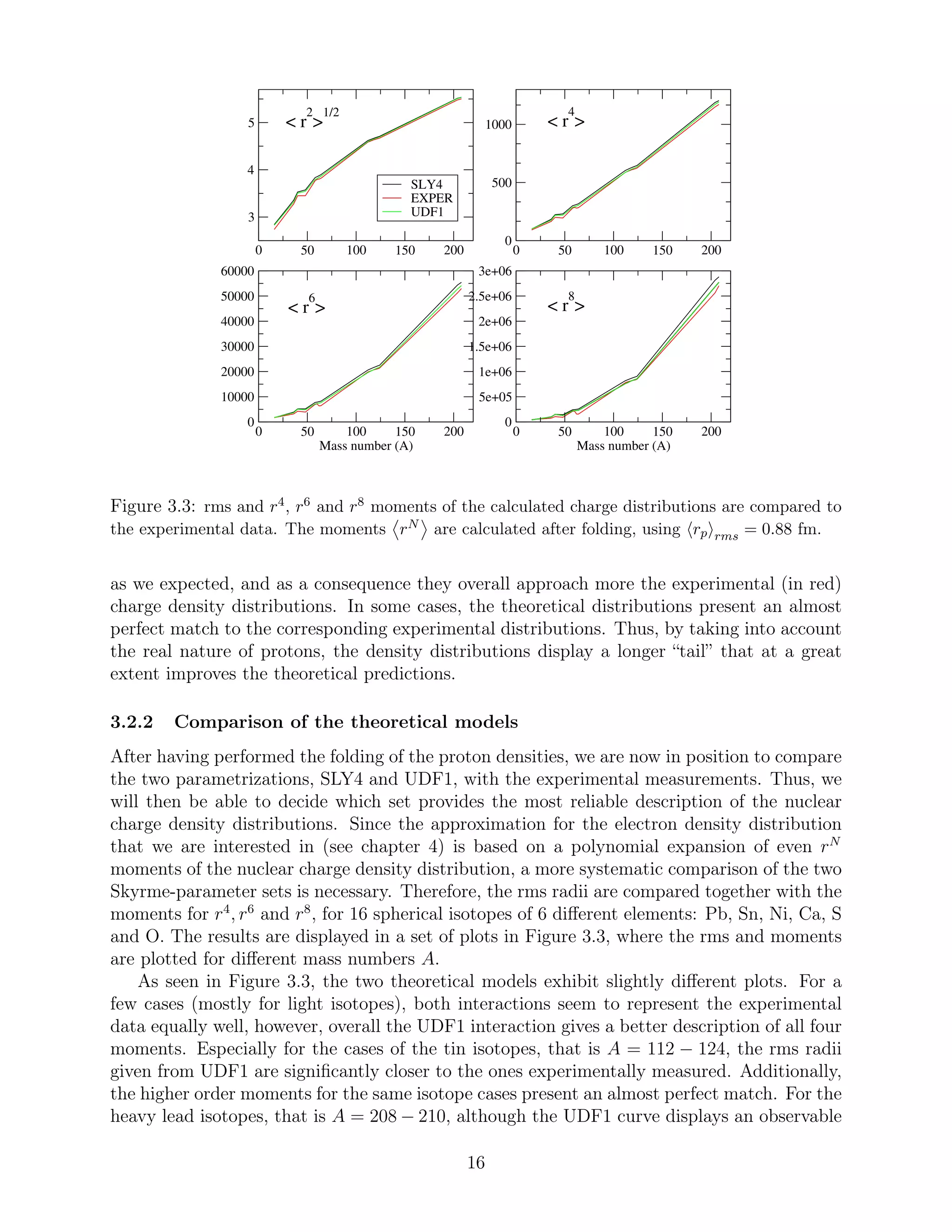
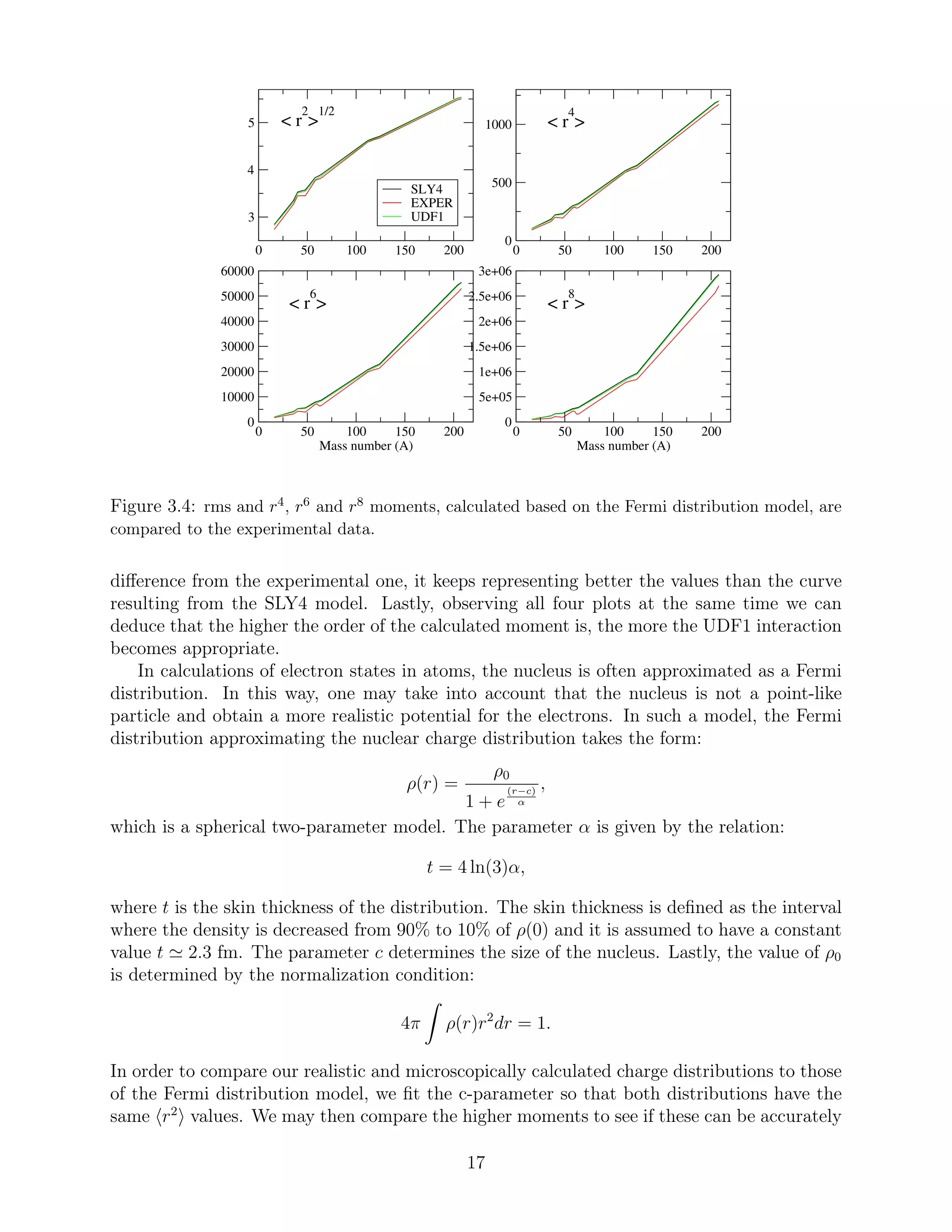
![described by the Fermi distribution. The results are displayed in Figure 3.4. Although the
r2
values are identical to the ones from the realistic HFB calculations, they are again shown
in this figure.
As seen in Figure 3.4, the use of different rms radii values (based on the SLY4 and
UDF1 calculations respectively) do not result in observable differences in the values of the
higher order moments, once the Fermi model is used in both cases to calculate them. Hence,
the black and green curves are almost identical in the r4
-, r6
- and r8
-moment plots.
Comparing Figure 3.4 to Figure 3.3, we deduce that the higher moments described by the
Fermi distribution present a larger difference from the experimental curve than the ones
predicted by the realistic SLY4 and UDF1 models. Therefore, the Fermi approximation of
the nuclear charge density distributions cannot represent the experimental data equally well,
especially when it comes to the r6
and r8
higher moments.
3.3 Accuracy of theoretical models
In this subsection we discuss the validity of the Skyrme nuclear interactions by demonstrating
their relative, to the experimental values, errors (R.E.) of rms radius, as well as r4
, r6
and
r8
moments. These are given by:
R.E. =
rN
theor − rN
exp
rN
exp
=
∆ rN
rN
exp
,
for N = 2, 4, 6 and 8 respectively. These errors are calculated for both the realistic HFB and
Fermi distributions and are discussed in subsections 3.3.1 and 3.3.2, respectively. In addition,
the rms values of these relative errors:
R.E.rms =
1
K
K
i=1
rN
i − rN
exp i
rN
exp i
2
have been calculated for all moments of both interactions and are also presented. K is the
total number of the isotopes studied, that is K = 16. Hence, a comparison between the SLY4
and UDF1 models can easier be carried out.
Lastly, the mean value of the errors for the rms radii can be compared to the corre-
sponding rms values of the typical experimental uncertainties [25]. The (R.E.RMS)exp are
indicatively calculated for the Pb and Ni isotopes. In subsection 3.3.3, the effect of the folding
procedure for different proton radius values is discussed and thus, conclusions can be drawn
about the effect of proton radius measurements on the calculations of nuclear charge density
distributions.
3.3.1 The realistic HFB models
Although a comparison between theoretical models and experimental measurements has al-
ready been performed in subsection 3.2.2, a quantitative analysis is also provided here in
order to highlight the appropriateness of the UDF1 set of parameters. As seen in Figure
3.5, the calculated errors for the values based on the UDF1 model are always smaller than
the ones based on the SLY4. This is valid for all four moments. Moreover, this allegation
18](https://image.slidesharecdn.com/f4d44770-da07-4f00-b74e-f72d1ffe325c-160216114919/75/A_Papoulia_thesis2015-19-2048.jpg)
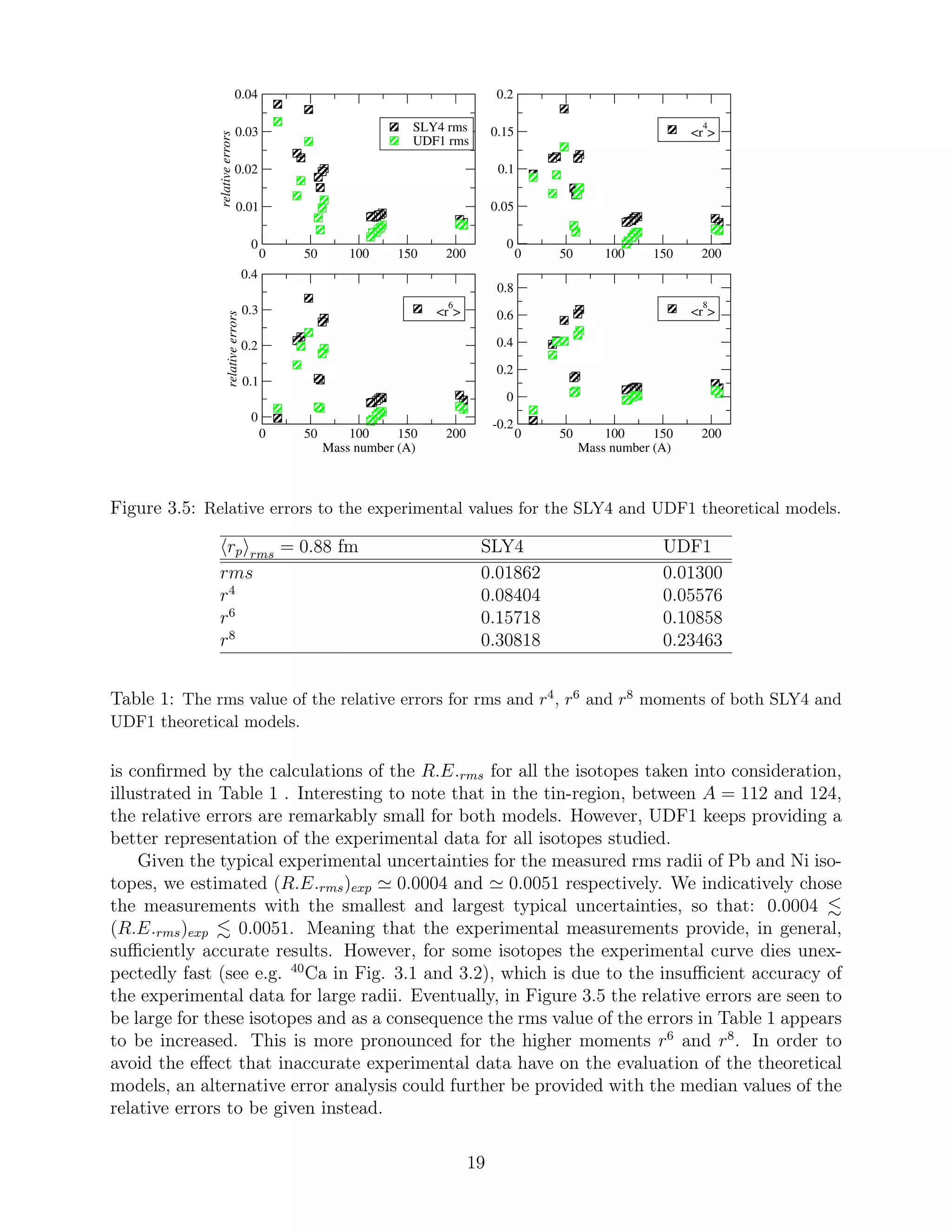
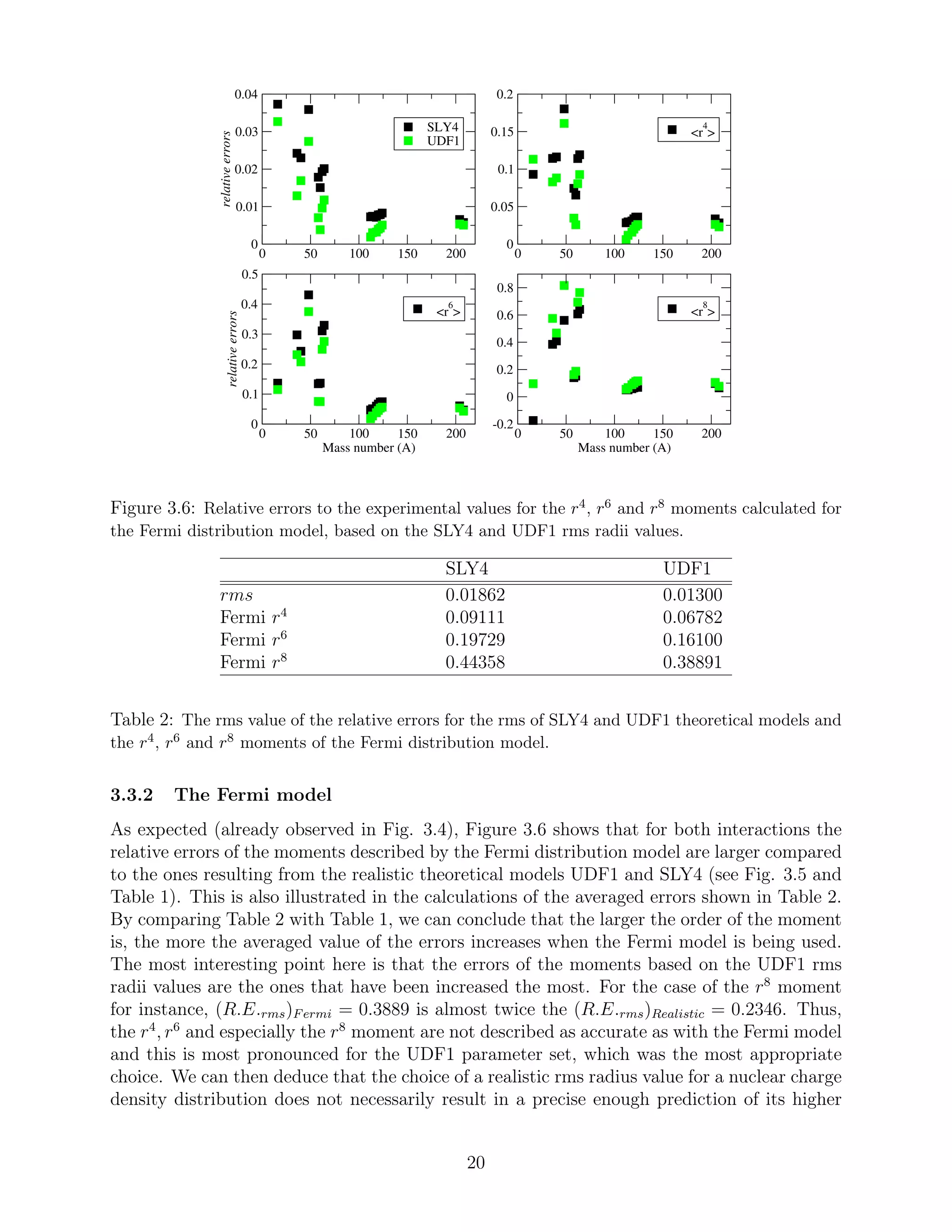
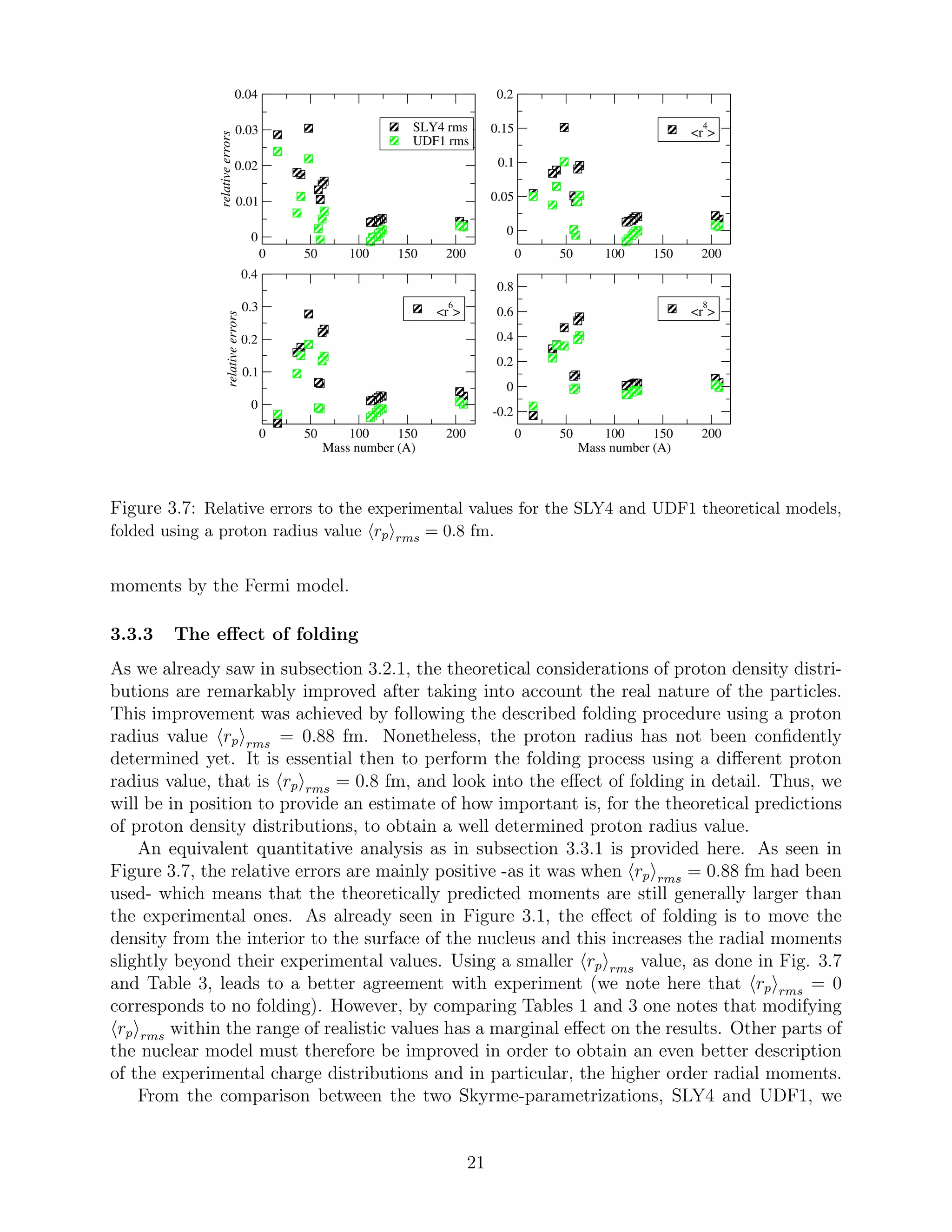

![where M and M′
are the atomic masses of the isotopes and Ki
NMS, Ki
SMS the mass-
independent, nuclear recoil normal and specific mass shift parameters [14] [24] [21]. The
corresponding line frequency isotope mass shift can then be written as:
δνA,A′
k,MS = δνA,A′
k,NMS + δνA,A′
k,SMS,
with
δνA,A′
k,MS = (
M′
− M
MM′
)
∆KMS
h
= (
M′
− M
MM′
)∆ ˜KMS,
where ∆KMS = ∆KNMS + ∆KSMS. Now, ∆KMS = (Ku
MS − Kl
MS) constitute the frequency
mass parameters for a transition k that connects the upper u and lower l level. The normal
and specific mass shift parameters are provided by the program ris3u [12] included in the
GRASP2K package. Hence, together with available nuclear mass data, isotope-dependent
energies and total isotope mass shifts are determined. The mass shift effect is dominant in
light systems, whereas in heavier systems its contribution becomes smaller.
4.2 Field shift
The isotope field shift (FS) arises from the differences in the nuclear charge density dis-
tribution between isotopes, which is caused by the different number of neutrons. Unlike
point-like charge distributions, realistic charge distributions alter the central field that the
bound atomic electrons experience. Hence, the extended charge distributions influence the
presence of the electrons inside the nuclear volume by pulling them out. The electron energy
levels and very likely the transition energies will then be affected. Evidently, the effect of the
nuclear distributions will be more pronounced for the electrons moving in s and p orbitals.
Moreover, the heavier the nuclear systems are, the more the electrons are pulled out and the
greater the FS becomes.
4.2.1 Variational approach
In the GRASP2K package [11], the multi-configuration Dirac-Hartree-Fock (MCDHF) method
provides an approximate solution of the atomic wave-functions. This method is the so-called
variational approach (VA), based on the minimization process of the total energy of the sys-
tem according to the variational principle (see chapter 2). Since in these calculations the
nucleus is assumed to have infinite mass, there is no MS effect contribution. Therefore, by
performing separate MCDHF calculations for two isotopes A and A′
with different parameter
set describing the respective charge distributions, the level field shift of an atomic level i is
calculated as:
δEA,A′
i,FS = EA′
i − EA
i ,
and consequently, the frequency transition field shift for a certain transition k will be given
by:
δνA,A′
k,FS ≡ νA′
k − νA
k =
δEA,A′
k,FS
h
,
where the difference δEA,A′
k = δEA,A′
u − δEA,A′
l is called transition field shift between the
chosen, upper u and lower l, levels. This method is highly model-dependent, since the shape of
the nucleus is approximated by a spherical two-parameter Fermi model (see subsection 3.2.2)
23](https://image.slidesharecdn.com/f4d44770-da07-4f00-b74e-f72d1ffe325c-160216114919/75/A_Papoulia_thesis2015-24-2048.jpg)
![in GRASP2K. Namely, the higher than r2
moments that determine the shape of the nuclear
charge distribution are predicted by a Fermi distribution having a diffuseness parameter
t = 2.3 fm and a radius parameter c tuned to reproduce the desired r2
moment. However,
the implementation of MCDHF provides the “exact” method for estimating the frequency
field shifts, serving as a benchmark when comparing to different perturbative approaches
below.
4.2.2 Perturbative methods
As seen in 4.2.1, the “exact” level field shifts are obtained by subtracting one atomic level
energy from another, which results in a tiny difference compared to the magnitude of the
undisturbed level energies Ei. Therefore, an alternative approach based on the first-order
perturbation theory may be used, so that the first-order level field shift of a level i can be
written as:
δE
(1)A,A′
i,FS = −
R3
[VA′ (r) − VA(r)]ρe
i (r)d3
r,
where VA(r) and VA′ (r) are the one-electron potentials arising from the different nuclear
charge distributions for the two isotopes A and A′
and ρe
i (r) is the electron density distribution
within the nuclear volume of the reference isotope A. In the theoretical considerations of
frequency field shifts, it is often assumed that the electron density is constant within the
nucleus, that is ρe
i (r) = ρe
i (0). The level and frequency field shifts can then roughly be
estimated as:
δE
(1)A,A′
i,FS ≈
2π
3
Zρe
i (0)δ r2 A,A′
= ̥i,1δ r2 A,A′
and
δν
(1)A,A′
k,FS ≈
Z
3
∆ρe
k(0)δ r2 A,A′
= Fk,1δ r2 A,A′
,
where ∆ρe
k(0) = ρe
u(0) − ρe
l (0) and ̥i,1, Fk,1 are the so-called electronic factors. Thus, the
field shift depends only on the difference between the second radial nuclear moments of the
chosen pair of isotopes.
This approximation works well as long as the atomic number is not too large. However,
in heavier systems, a reformulation of the field shift is needed, where the shape of the elec-
tron density inside the nucleus is taken into account. Assuming extended nuclear charge
distributions, it can be shown that the electron density to a very good approximation can be
expanded, around r = 0, as an even polynomial function:
ρe
i (r) ≈ b(r) = bi,1 + bi,2r2
+ bi,3r4
+ bi,4r6
,
so that the first-order level field shift is given by the expansion [12] [20] [5] [10]:
δE
(1)A,A′
i,FS =
4
N=1
̥i,N δ r2N A,A′
,
where the level electronic factors now are ̥i,N = 2π
N(2N+1)
Zbi,N for a certain atomic number
Z and δ r2N A,A′
= r2N A′
− r2N A
are the differences of the nuclear radial moments, of
24](https://image.slidesharecdn.com/f4d44770-da07-4f00-b74e-f72d1ffe325c-160216114919/75/A_Papoulia_thesis2015-25-2048.jpg)
![order 2N for N = 1, 2, 3 and 4, for isotopes A, A′
. Accordingly, the first-order frequency field
shift will be given by:
δν
(1)A,A′
k,FS =
4
N=1
Fk,N δ r2N A,A′
,
where Fk,N = 1
N(2N+1)
Z∆bk,N are the frequency electronic factors, related to the change in
the electronic density inside the nucleus, with ∆bk,N = bu,N − bl,N defining the difference of
the polynomial function coefficients between the upper u and the lower l level.
The electron density ρe
(r) is constructed using ris3u [12] [10], one of the GRASP2K
programs. Subsequently, this density is fitted to the polynomial function b(r) so that the
coefficients bi,N and their differences ∆bk,N can be calculated. Finally, the level and frequency
electronic factors, ̥i and Fk,N , are deduced for the reference isotope A. This approach is
not constrained to any approximated model describing the nuclear charge density distribu-
tions. Therefore, the realistic nuclear radial moments extracted from the Skyrme-type UDF1
interaction can be used in order to estimate the frequency shifts for several transitions and
isotope pairs.
4.2.3 Validation of perturbative method
Since the variational approach stands so far for the best approximation to the field shifts,
this method will serve as the verification instrument for the newly introduced perturbative
method. The charge distributions in the VA are based on a two-parameter spherical Fermi
model. For this model we adopt the same rms radii as given in Angelis & Marinova [2] that
was used in the VA and for higher moments given by the Fermi model, should be virtually
identical.
The validation of the RFS is illustrated in Figure 4.1, for three different Lithium-like
lead isotope pairs and two different transitions k. In each pair, the 208
Pb is used as the
reference isotope A and the electronic field shift factors are deduced for this nucleus. Hence,
the frequency field shifts are plotted in relation to the mass number A′
of the non-reference
isotope. As seen in Figure 4.1, after adding all four expansion terms (red circle), the frequency
field shifts δν
(1)208,A′
k almost perfectly agree with the δν208,A′
k,V A (black square) resulting from
the variational approach described in 4.2.1. Namely, the perturbative method provides us
with rather satisfactory results. Additionally, the accumulated frequency field shift values,
δν208,A′
k, N=1,n
for n = 1, 2, 3, are displayed in the same plot for all three isotope pair combinations
208, A′
. The δν208,A′
k, N=1,n
give three different frequency field shift values after each expansion
term has been consecutively added, before the final δν
(1)208,A′
k is deduced. We notice that
for n = 1, we obtain δν208,A′
k, N=1,1
= Fk,1δ r2 208,A′
(green ring), which is the frequency field
shift estimated using the assumption of constant electron density inside the nucleus. It is
noteworthy here that the higher than second order moments evidently play an important
role in the expansion of the reformulated frequency field shift, proving that the shape of the
electron density inside such heavy nuclear systems always needs to be taken into account.
In order to perform a quantitative comparison of the contribution rate from each expansion
term, the isolated term contributions are presented in Table 4 for the isotope pair 208,200
Pb.
The accumulated contributions and contribution percentages are also displayed. As seen
in Table 4, the terms that include the nuclear radial moments differences δ r2N 208,200
for
25](https://image.slidesharecdn.com/f4d44770-da07-4f00-b74e-f72d1ffe325c-160216114919/75/A_Papoulia_thesis2015-26-2048.jpg)
![190 195 200 205 210 215
Mass number (A’)
-20000
0
20000
40000
60000
δν
208,A’
[GHz]
VA
Reformulated
1st Exp. term
2nd Exp. term
3rd Exp. term
Transition 1
190 195 200 205 210 215
Mass number (A’)
-20000
0
20000
40000
60000
Transition 2
Figure 4.1: The frequency field shift δν208,A′
for the Li-like Pb isotope pairs with A′ = 192, 200
and 210. “Transition 1” refers to 1s22s 2S1/2+ −→ 1s22p 2P1/2− transition, while “transition 2” is
addressed to the 1s22s 2S1/2+ −→ 1s22p 2P3/2− transition. The δν208,A′
V A resulting from the vari-
ational approach (VA) calculations, as well as the accumulated frequency field shifts δν208,A′
N=1,n
=
n
N=1
Fk,N δ r2N 208,A′
for n = 1, 2, 3, 4 resulting from the perturbative approach, are separately
demonstrated.
26](https://image.slidesharecdn.com/f4d44770-da07-4f00-b74e-f72d1ffe325c-160216114919/75/A_Papoulia_thesis2015-27-2048.jpg)
![n δν208,200
n [GHz] δν208,200
N=1,n
[GHz]
δν208,200
N=1,n
δν208,200
V A
[%] δν208,200
n
δν208,200
V A
[%]
1 30895.8235 30895.8235 108.172 108.172
2 -2717.8996 28177.9239 98.656 -9.516
3 505.9503 28683.8742 100.428 1.771
4 -59.2375 28624.6367 100.220 -0.207
δν208,200
V A 28561.7494 100
Table 4: Column two contains the isolated contributions δν208,200
n = Fk,nδ r2n 208,200
that each one
out of the four in total expansion terms gives to the final
4
N=1
Fk,N δ r2N 208,200
frequency field shift
value of the 208,200Pb pair calculated for 1s22s 2S1/2+ −→ 1s22p 2P1/2− transition, whilst column
three displays the accumulated contributions δν208,200
N=1,n
=
n
N=1
Fk,N δ r2N 208,200
. The r2 values
are taken from Angelis & Marinova [2]. In column four, the matching percentage of the accumulated
contributions is estimated based on the δν208,200
V A value. Lastly, the matching percentages of the
isolated contributions are presented in column five.
N = 2, 3, 4 give almost 8% contribution to a precise evaluation of the field shifts, meaning
that the constant electron density approximation is not good enough for the description of the
heavy nuclear systems. Nonetheless, the major correction comes from the second expansion
term that takes into account the differences between the r4
moments. However, from the
values of the accumulated percentages we draw the conclusion that the expansion converges
to a slightly higher value than the one given by the δν208,200
V A . Thus, the reformulation of the
field shift remains an approximation to the “exact” VA method. The observed discrepancy
is mainly due to the fact that the same electron density, deduced for the reference isotope
A = 208, is used in both nuclei. Other assumptions that have been made throughout the
formulation of the perturbative approach are expected to play a minor role.
5 The effect of realistic nuclear charge distributions
In chapter 4, the alternative approach introduced for estimating field shifts was validated.
This approach is rather powerful since it enables the investigation of the effect that more
realistic nuclear charge distributions have on level and frequency field shifts. In this section,
we initially focus on the magnitude of the higher order contributions in the reformulated
field shift, using theoretically predicted r4
, r6
and r8
moments. The corrections provided
by the realistic charge distributions are compared to the uncertainties of the experimentally
observed field shifts. Conclusions can then be drawn on the importance of such corrections
depending on whether or not these could be detected by making use of the current experi-
mental techniques. Ultimately, extraction of nuclear radial moment differences, δ r2N
for
N = 1, 2, 3 and 4, is discussed assuming that four independent transitions are available. How-
ever, a novel approach, where only two transitions are needed for the extraction of higher
27](https://image.slidesharecdn.com/f4d44770-da07-4f00-b74e-f72d1ffe325c-160216114919/75/A_Papoulia_thesis2015-28-2048.jpg)
![order radial moments, will also be outlined.
5.1 Higher order moments in field shift
In the electronic calculations, the shape of the nuclear charge density distribution is approx-
imated by the two-parameter spherical Fermi model described in subsection 3.2.2. However,
the reformulation of the field shift enables calculations based on realistic nuclear charge dis-
tributions. Hence, the main objective in this section is to examine the magnitude of the
corrections δνrealistic − δνFermi. We fit the Fermi distribution so that it has the same r2
value as the realistic distribution. Then:
δνFermi = Fk,1δ r2
realistic
+
4
N=2
Fk,N δ r2N
Fermi
,
and
δνrealistic =
4
N=1
Fk,N δ r2N
realistic
.
Therefore, the frequency field shifts calculated using realistic charge distributions can be
equivalently written:
δνrealistic = Fk,1δ r2
realistic
+
4
N=2
Fk,N δ r2N
Fermi
+ (δνrealistic − δνFermi),
treating the correction δνrealistic − δνFermi as an additional term. For spherical nuclei, the
realistic nuclear radial moments are extracted from the charge density distributions described
by the Skyrme-based UDF1 interaction (see chapter 3). For deformed nuclei the realistic
nuclear moments are calculated with the same interaction using the program HFBTHO
(2.00d) [22].
We focus on heavy nuclear systems where the splitting of the energy values and transitions
are larger. Besides, it is in these systems where the higher order moments contribute to a
considerable extent. The orbitals that are affected the most by the change in the nuclear
charge distributions between the isotopes are the ones closest to the nucleus. Therefore,
transitions exclusively between s and p orbitals are examined here.
5.1.1 Spherical nuclei
The contribution from the “correction term” δνrealistic − δνFermi is plotted in Figure 5.1 for a
variety of Lithium-like systems with spherical nuclei. The Li-like system of lead Pb79+
, for
which several isotope pair combinations have been studied, is of main interest. As seen in
Figure 5.1, the absolute magnitude of the “correction term” mainly depends on the difference
between the neutron number ∆N208,A′
(or equivalently the difference between the mass num-
ber ∆A208,A′
) for the isotopes 208, A′
of the chosen pair. The larger the difference ∆N208,A′
is, the more important the role of the corrections becomes. When more neutrons are added
it is expected that they will pull out the protons, leading to an increased diffuseness of the
distribution. This effect is not included in the Fermi model and may be a reason for the
28](https://image.slidesharecdn.com/f4d44770-da07-4f00-b74e-f72d1ffe325c-160216114919/75/A_Papoulia_thesis2015-29-2048.jpg)
![100 150 200 250 300
Mass number (A’)
-200
-100
0
100
200
(δνrealistic
−δνFermi
)[GHz]
120,A’
Sn
208,A’
Pb
198,194
Er
304,300
Uuh
∆N
208,A’
= 24
∆Ν
208,Α
= 2
208
Pb120
Sn
Figure 5.1: The corrections δνrealistic − δνFermi to the frequency field shift calculations in relation
to the mass number A′ of the non-reference isotope. The results for the Li-like lead Pb79+ isotope
pairs 208,A′
Pb for A′ = 184, 192, 200, 210 and 214 are illustrated in blue and the ones for the Li-like
tin, 120,114Sn and 120,126Sn, in black. The reference isotopes used in these pair combinations, 208Pb
and 120Sn, are pointed out with red. The result for the Li-like ununhexium pair 300,304Uuh is shown
in green. All plotted values refer to the transition 1s22s 2S1/2+ −→ 1s22p 2P1/2− .
29](https://image.slidesharecdn.com/f4d44770-da07-4f00-b74e-f72d1ffe325c-160216114919/75/A_Papoulia_thesis2015-30-2048.jpg)
![n δν208,200
n [GHz] δν208,200
N=1,n
[GHz]
δν208,200
N=1,n
δν208,200
N=1,5
[%] δν208,200
n
δν208,200
N=1,5
[%]
1 35965.7809 35965.7809 108.205 108.205
2 -3210.1387 32755.6422 98.547 -9.658
3 599.4241 33355.0663 100.351 1.804
4 -70.7353 33284.3311 100.138 -0.203
5 -45.8809 33238.4501 100 -0.138
Table 5: Column two contains the isolated contributions δν208,200
n to the final frequency field shift
value of the 208,200Pb pair and the transition 1s22s 2S1/2+ −→ 1s22p 2P1/2− . For n = 1, 2, 3 and
4, δν208,200
n = Fk,nδ r2n 208,200
are given by the expansion terms of the reformulated frequency
field shift. The δ r2 is given by the realistic rms radii values of the isotopes, based on the UDF1
interaction, while δ r2N for n = 2, 3, 4 are given by the higher moments reproduced using a Fermi
model that is formed on the UDF1 rms radii. Lastly, δν208,200
5 represents the “correction term”
δνrealistic − δνFermi. Column three displays the accumulated contributions δν208,200
N=1,n
, with δν208,200
N=1,5
being the δνrealistic. In column four, the matching percentage of the accumulated contributions is
estimated based on the final δνrealistic value, whilst column five contains the matching percentages
of the isolated contributions.
observed difference. However, these corrections are tiny for the much lighter system of (Li-
like) Tin. In order to stress the larger magnitude of the effect that realistic higher order
nuclear moments have on the frequency field shift estimated in heavy systems, the value of
δνrealistic − δνFermi has been calculated for the extreme case of the superheavy neutron-rich
ununhexium element of proton number Z = 116. As seen in Figure 5.1, even for the small
change ∆N = 4, the corrections in superheavy systems can be hundred times larger than the
ones in lighter systems.
A quantitative analysis of the magnitude of the “correction term” δνrealistic − δνFermi, as
well as its contribution percentage to the final realistic frequency field shift value δνrealistic
for the isotope pair 208,200
Pb is displayed in Table 5. As seen in Table 5, the additional term
δνrealistic − δνFermi gives ≃ 0.14% contribution, which is smaller than the one resulting from
the fourth expansion term. However, for isotope pairs with larger ∆N, like the 208,184
Pb,
the correction adds a contribution that reaches 0.26%, which in this case is larger than
the contribution of the last expansion term (≃ 0.2%). Therefore, we deduce that even in
nuclear systems that are spherical the two-parameter Fermi model may not always provide a
satisfactory description of the higher order moments that are used in the calculations of the
RFS.
5.1.2 Deformed nuclei
The two-parameter Fermi model does not take into account the effect of deformation. As a
result, the effect of the realistic charge distributions on the field shifts is expected to be even
larger in atomic systems where the nuclei are deformed. In such systems, the axially symmet-
ric deformed Fermi model is suggested to be used instead. The nuclear charge distributions
are in this case given by:
30](https://image.slidesharecdn.com/f4d44770-da07-4f00-b74e-f72d1ffe325c-160216114919/75/A_Papoulia_thesis2015-31-2048.jpg)
![100 150 200 250
Mass number (A’)
-100
0
100
200
(δνrealistic
−δνFermi
)[GHz]
142,A’
Nd
208,A’
Pb
β ~0.35
β ~0.14
208
Pb
142
Nd
120
Sn
120,A’
Sn
β ∼0.29
Figure 5.2: The corrections δνrealistic − δνFermi to the frequency field shift calculations in relation
to the mass number A′ of the non-reference isotope. The results for the Li-like spherical lead
Pb79+ isotope pairs are illustrated in blue, while Li-like deformed neodymium Nd57+ isotope pairs
are displayed in green. For Nd57+, the magnitude of the quadrupole deformation parameter β of
the non-reference isotopes A′ is indicatively shown for two different isotope groups. The reference
isotopes used in the pair combinations, 208Pb, 142Nd and 120Sn, are all spherical and are pointed
out with red. All plotted values refer to the 1s22s 2S1/2+ −→ 1s22p 2P1/2− transition.
0 0.05 0.1 0.15 0.2 0.25 0.3 0.35 0.4
beta (β)
0
50
100
150
200
(δνrealistic
−δνFermi
)[GHz]
Nd
57+
∆N
142,A’
= 4
∆N
142,A’
= 6
Figure 5.3: The corrections δνrealistic − δνFermi to the frequency field shift calculations in relation
to the quadrupole deformation parameter β of the non-reference A′ isotope for various Nd57+ isotope
pairs. In all pairs, the reference isotope is the spherical 142Nd. Two cases of isotope pairs 142, A′ with
the same difference ∆N142,A′
in the neutron number but different δνrealistic − δνFermi magnitude,
due to the deformation β, are indicatively stressed.
31](https://image.slidesharecdn.com/f4d44770-da07-4f00-b74e-f72d1ffe325c-160216114919/75/A_Papoulia_thesis2015-32-2048.jpg)
![ρ(r, θ) =
1
1 + e
r−c(θ)
a
,
where, if only quadrupole deformation is considered, c(θ) = c0[1+β20Y20(θ)]. The “correction
term” δνrealistic − δνFermi can now be decomposed into two parts and written as:
δνrealistic − δνFermi = δνrealistic − δνdef
Fermi + δνdef
Fermi − δνsph
Fermi .
The δνdef
Fermi − δνsph
Fermi part isolates the magnitude of the effect of deformation, while the
δνrealistic − δνdef
Fermi part gives the magnitude of the corrections due to other effects, like for
instance the density wiggles and the varied diffuseness that are not taken into account in the
simplified Fermi approximation. In order to separately estimate the effect of deformation,
we additionally calculated the frequency field shifts based on the higher order moments that
are predicted by the deformed Fermi model. The deformed Fermi model is for each nuclear
system developed based on a certain quadrupole deformation parameter β, in addition to the
realistic rms radius of the nucleus, which is theoretically predicted by the HFBTHO (2.00d)
program.
The Li-like system of neodymium is of great interest since the theoretically calculated
frequency field shifts can be further compared to the available experimental data. There-
fore, in Figure 5.2, the contribution to the frequency field shifts from the “correction term”
δνrealistic − δνFermi in relation to the mass number A′
of the non-reference isotope is plotted
for a variety of ion pairs Nd57+
, in addition to the Pb79+
and Sn47+
pairs plotted in Figure 5.1.
While the reference isotope 142
Nd is spherical, the non-reference isotope is always deformed
to a certain extent. As seen in Figure 5.2, the corrections become significant and comparable
to the heavy Li-like system of lead whenever the value of the deformation parameter β for
the non-reference isotope is large. On the other hand, in light systems and when the nuclei
have approximately spherical shape the δνrealistic − δνFermi value is negligible. This ascer-
tainment has been already highlighted for the Li-like system of tin, where all isotopes in the
pair combinations are purely spherical and as a consequence δνrealistic − δνFermi ≃ 0.
The magnitude of δνrealistic − δνFermi in relation to the deformation parameter β of the
non-reference isotope is plotted for the Nd57+
ion pairs in Figure 5.3. As seen in Figure 5.3,
there is roughly a quadratic increase of the δνrealistic − δνFermi value with the deformation.
Therefore, in lighter and deformed nuclear systems, we deduce that the change in the neutron
number ∆NA,A′
between two isotopes is not as an important factor for the estimation of the
correction δνrealistic − δνFermi as it is in the heavier systems.
In order to be able to draw conclusions about the significance of the “correction term”
in comparison to the magnitude of each one of the expansion terms, as well as the total
frequency field shift value δνrealistic, a quantitative analysis based on the isotope pair 142,150
Nd
is displayed in Table 6. Table 6 provides a similar illustration of the contributions and the
contribution percentages from each term as Table 5 does in 5.1.2. As seen in Table 6, the
term δνrealistic − δνFermi adds a contribution of ≃ 1.16% to the formulation of the frequency
field shift δνrealistic. The contribution of the corrections provided by the usage of realistic
nuclear data is now larger than the contribution from the third and fourth expansion terms
when they are summed up, which reaches ≃ 1.03%. More specifically, the major contribution
comes from the δν142,150
5 term, that is due to the usage of the deformed Fermi model. Further
on, the δν142,150
6 term, which is due to the wiggles, the skin diffuseness etc. of the realistic
32](https://image.slidesharecdn.com/f4d44770-da07-4f00-b74e-f72d1ffe325c-160216114919/75/A_Papoulia_thesis2015-33-2048.jpg)
![n δν142,150
n [GHz] δν142,150
N=1,n
[GHz]
δν142,150
N=1,n
δν142,150
N=1,6
[%] δν142,150
n
δν142,150
N=1,6
[%]
1 -12979.2841 -12979.2841 105.609 105.609
2 647.7010 -12331.5831 100.339 -5.270
3 -113.5695 -12445.1526 101.263 0.924
4 12.6588 -12432.4937 101.160 -0.103
5 104.7742 -12327.7195 100.316 -0.844
6 37.8273 -12289.8922 100 -0.316
Table 6: In column two the isolated contributions δν142,150
n to the final frequency field shift value
of the 142,150Nd57+ pair calculated for 1s22s 2S1/2+ −→ 1s22p 2P1/2− transition are shown. For
n = 1, 2, 3 and 4, δν142,150
n = Fk,nδ r2n 142,150
are given by the expansion terms of the refor-
mulated frequency field shift. The δ r2 are given by the theoretically calculated rms radii of
the isotopes, while δ r2N for n = 2, 3, 4 are given by the higher moments reproduced using the
spherical two-parameter Fermi model that is formed on the theoretical rms radii. Lastly, the sum
δν142,150
5 +δν142,150
6 represents the correction δνrealistic−δνFermi, where δν142,150
5 = δνdef
Fermi−δνsph
Fermi
and δν142,150
6 = δνrealistic −δνdef
Fermi. Column three displays the accumulated contributions δν142,150
N=1,n
,
with δν142,150
N=1,6
being the δνrealistic. In column four, the matching percentage of the accumulated con-
tributions is estimated based on the final δνrealistic value, whilst column five contains the matching
percentages of the isolated contributions.
distributions, adds a contribution of ≃ 0.32% that, as seen in Table 6, exceeds the one from
the fourth expansion term. Therefore, in deformed nuclear systems the two-parameter Fermi
model seems to be even less appropriate for the description of the r2N
, N = 2, 3 and 4,
moments than it was in the case of the spherical nuclei.
5.2 Experimental isotope shifts
The isotope shift (IS) calculations, and particularly the estimation of the corrections δνrealistic−
δνFermi to the field shifts that are provided when realistic nuclear data are used, become
more meaningful when the comparison with experimental IS observations is feasible. The
comparison of these corrections with the experimental uncertainties is also of interest since it
will reveal if the corrections should be included in the analysis and eventually if they can be
extracted from observed IS. In Li-like systems, highly accurate IS observations remain a chal-
lenge, since they are followed by relatively -compared to neutral systems- high uncertainties,
both statistical and systematic. The Li-like system of neodymium Nd57+
has been studied
and the observed isotope frequency shift is δν142,150
IS,exp = −9720(73)(145) GHz [(stat)(syst)] for
the 1s2
2s 2
S1/2+ −→1s2
2p 2
P1/2− transition and δν142,150
IS,exp = −10228(290)(484) GHz for the
1s2
2s 2
S1/2+ −→1s2
2p 2
P3/2− transition [9]. The mass shift contribution is mainly significant
in lighter systems. However, in order to obtain a reliable estimate of the “observed” frequency
field shift, subtraction of the MS component is required. For the same transitions, the total
mass shift, in the same work, were calculated to be δν142,150
MS = −387 GHz and δν142,150
MS = −435
GHz. Hence, the estimated “observed” field shift is finally δν142,150
FS,exp = −10107(73)(145) GHz
33](https://image.slidesharecdn.com/f4d44770-da07-4f00-b74e-f72d1ffe325c-160216114919/75/A_Papoulia_thesis2015-34-2048.jpg)
![and δν142,150
FS,exp = −10663(290)(484) GHz, for each transition, respectively.
As seen in Table 6, for the 1s2
2s 2
S1/2+ −→1s2
2p 2
P1/2− transition δν142,150
Fermi = −12432
GHz, which after taking into account the corrections δνrealistic − δνFermi = 142 GHz takes
the value δν142,150
realistic = −12290 GHz. The calculated frequency field shift approaches the
“observed” value after the “correction term” has been added, but δν142,150
realistic is still ∼ 20%
smaller than δν142,150
FS,exp . A similar difference between “observed” and theoretically predicted
frequency field shift is obtained for the 1s2
2s 2
S1/2+ −→1s2
2p 2
P3/2− transition. Considering
the differences between experimental and theoretical rms radii, the large difference between
the corresponding frequency field shift values is not surprising. From the Angelis & Marinova
compilation [2] we obtain δ r2 142,150
exp = 1.27 fm2
, whereas the HFBTHO calculations result in
δ r2 142,150
realistic = 1.64 fm2
(∼ 20% larger). The calculated charge distributions are not expected
to be 100% exact when it comes to rms radii and particularly δ r2
values. However, they
should be realistic in terms of nuclear shapes and deformation and thus providing a more
representative description of the higher order moments.
In the particular case of 142,150
Nd where the target isotope 150
Nd is deformed, the cor-
rection is δνrealistic − δνFermi = 142 GHz > 73 GHz, which is the magnitude of the sta-
tistical uncertainty in the measurement of the δν142,150
IS,exp . The role of the “correction term”
δνrealistic − δνFermi is even more stressed when the higher moments differences δ r2N
are
extracted from the observed IS. Taking δν142,150
FS,exp = −10107(73)(145) GHz for the 1s2
2s
2
S1/2+ −→1s2
2p 2
P1/2− transition, we can extract δ r2
assuming a linear dependence:
δν142,150
FS,exp ≃ Cδ r2
.
The constant C for this particular transition is estimated using GRASP2K. We performed
separate MCDHF calculations for 142
Nd ( r2 1/2
= 4.9118 fm2
) and 150
Nd ( r2 1/2
= 5.0415
fm2
), having as a reference the former isotope and using t = 2.30 fm for both isotopes. The
reformulated field shift is δν142,150
= −9745 GHz and the “effective” field shift electronic
factor becomes:
F =
δν142,150
δ r2 142,150 =
−9745
1.2909
= −7549
GHz
fm2
.
Assuming a “dummy” isotope with r2
= r2 142
+ 1.00 fm2
and calculating the relative field
shift yields an electronic factor F′
that has almost the same magnitude as the one calculated
before so that F′
≃ F. Therefore, we can, to a good enough approximation, assume that
F = C and rely on the linearity of the field shift parameter in GHz/fm2
. Using the “observed”
field shift, we obtain:
δ r2
=
δν142,150
FS,exp
F
= 1.3389fm2
.
By taking into account the effect of the realistic charge distribution, the field shift electronic
factor takes the value:
Fcor = F +
δνrealistic − δνFermi
δ r2
realistic
= −7462
GHz
fm2
.
Using again the “observed” field shift, we obtain:
δ r2
cor
=
δν142,150
FS,exp
Fcor
= 1.3545fm2
.
34](https://image.slidesharecdn.com/f4d44770-da07-4f00-b74e-f72d1ffe325c-160216114919/75/A_Papoulia_thesis2015-35-2048.jpg)
![In the work by Brandau et al. [9], the extracted δ r2
for the same transition is 1.36(1)(3) fm2
.
The δ r2
and δ r2
cor that we estimated above are slightly different due to the fact that some
small corrections from additional effects have been neglected throughout our calculations of
the “observed” field shift, whereas in the analysis of Brandau these effects have been taken
into account and subtracted from the observed IS δν142,150
IS,exp . The difference between the δ r2
and the δ r2
cor is ∼ 0.016 fm2
, which is larger than the statistical error but smaller than
the systematical error. Hence, in this case the effect from the realistic charge distributions
is important and comparable in magnitude to the observed uncertainty. It is possible to
double-check the δ r2
value by using the observed IS of the second available transition
and calculating the relevant electronic factor F, but for this transition both statistical and
systematic error are larger and thus better resolution is needed in order to see the effect of
the realistic charge distributions.
5.3 Extracting higher moments from data
The reformulation of the field shift combined with experimental isotope shifts δν
(exp)A,A′
k,IS
enables the extraction of the radial nuclear moments r2N
, N = 1, 2, 3, 4 for the target isotope
A′
, when the corresponding moments are known for the reference isotope A. Thus, conclusions
can be drawn about the nuclear shapes, deformations, density wiggles and other nuclear
properties. The extraction of all four radial moments requires four independent transitions
k to be available. A system of four equations is then solved for:
δνexp
k,IS − δνk,MS = Fk,1δ r2
+ Fk,2δ r4
+ Fk,3δ r6
+ Fk,4δ r8
,
where k = 1, 2, 3, 4. The frequency electronic factors Fk,N and the frequency mass shift
parameters ∆Kk,MS, different for each transition k, may theoretically be calculated using an
atomic structure code such as GRASP2K. However, it is rare that observed IS are available
for four transitions and in addition such systems of equations cannot be formed so that they
give trustworthy solutions for the higher than second order moments.
Looking back at Figure 4.1, we can say that the major correction, to the approximation
that assumes constant electron density ρe
i (r) = ρe
i (0), comes from the second expansion term,
i.e. Fk,2δ r4
, which takes into account the differences between the r4
moments. Nonethe-
less, the contribution from the
4
N=3
Fk,N δ r2N
part of the expression for the reformulated
frequency field shift remains not negligible. This is also illustrated in Figure 5.4, where the
matching percentage to the final frequency shift value
4
N=1
Fk,N δ r2N 208,200
of the isotope pair
208,200
Pb has been plotted after each term is added. Obviously, when the fourth expansion
term is taken into account, the final field shift value is reached. As seen in Figure 5.4, the 4th
order radial moments add ∼ 10% contribution, the 6th moments add ∼ 2% contribution and
the last term, which contains the 8th order moments, contributes with much less. However,
a re-arrangement of the sum that gives the RFS could possibly lead to faster convergence.
35](https://image.slidesharecdn.com/f4d44770-da07-4f00-b74e-f72d1ffe325c-160216114919/75/A_Papoulia_thesis2015-36-2048.jpg)
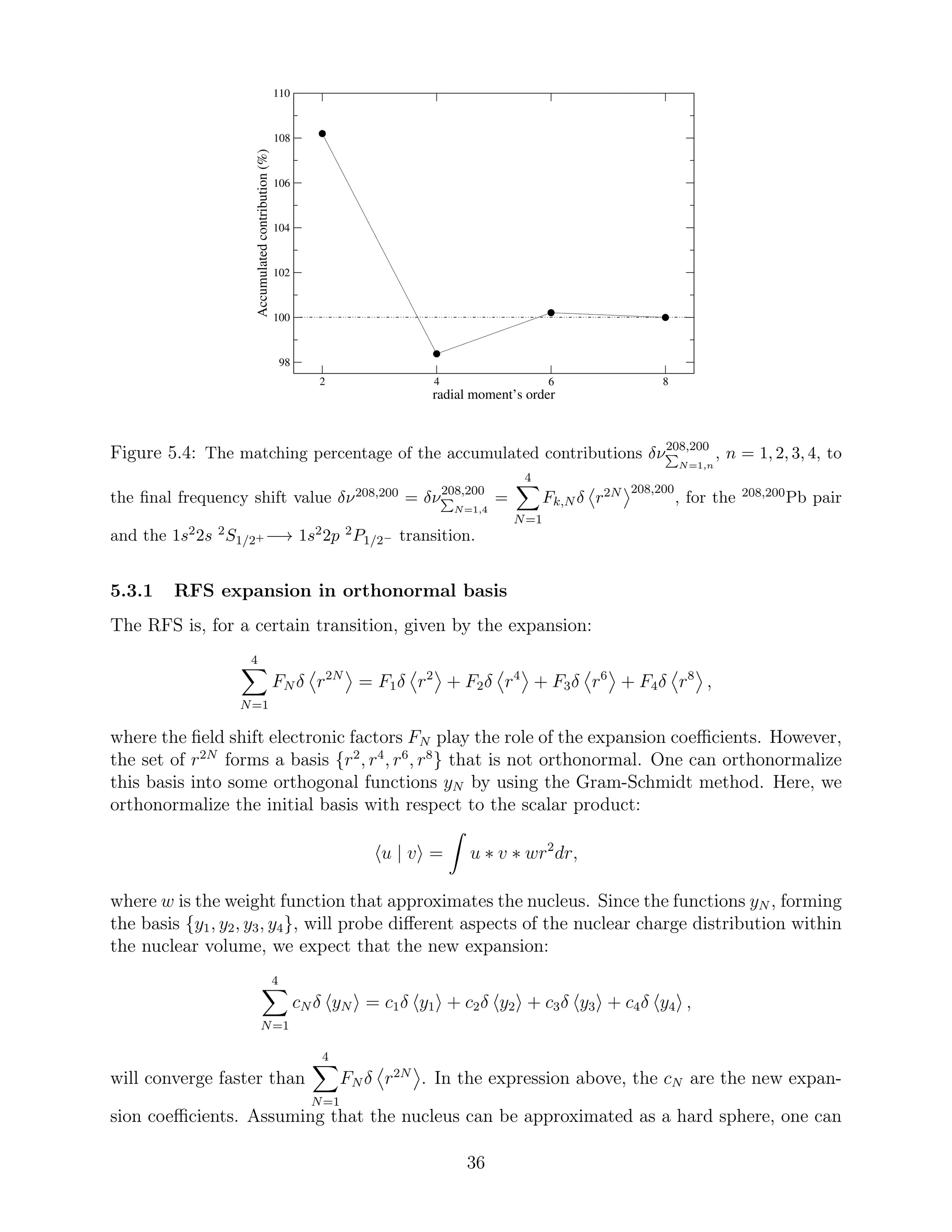
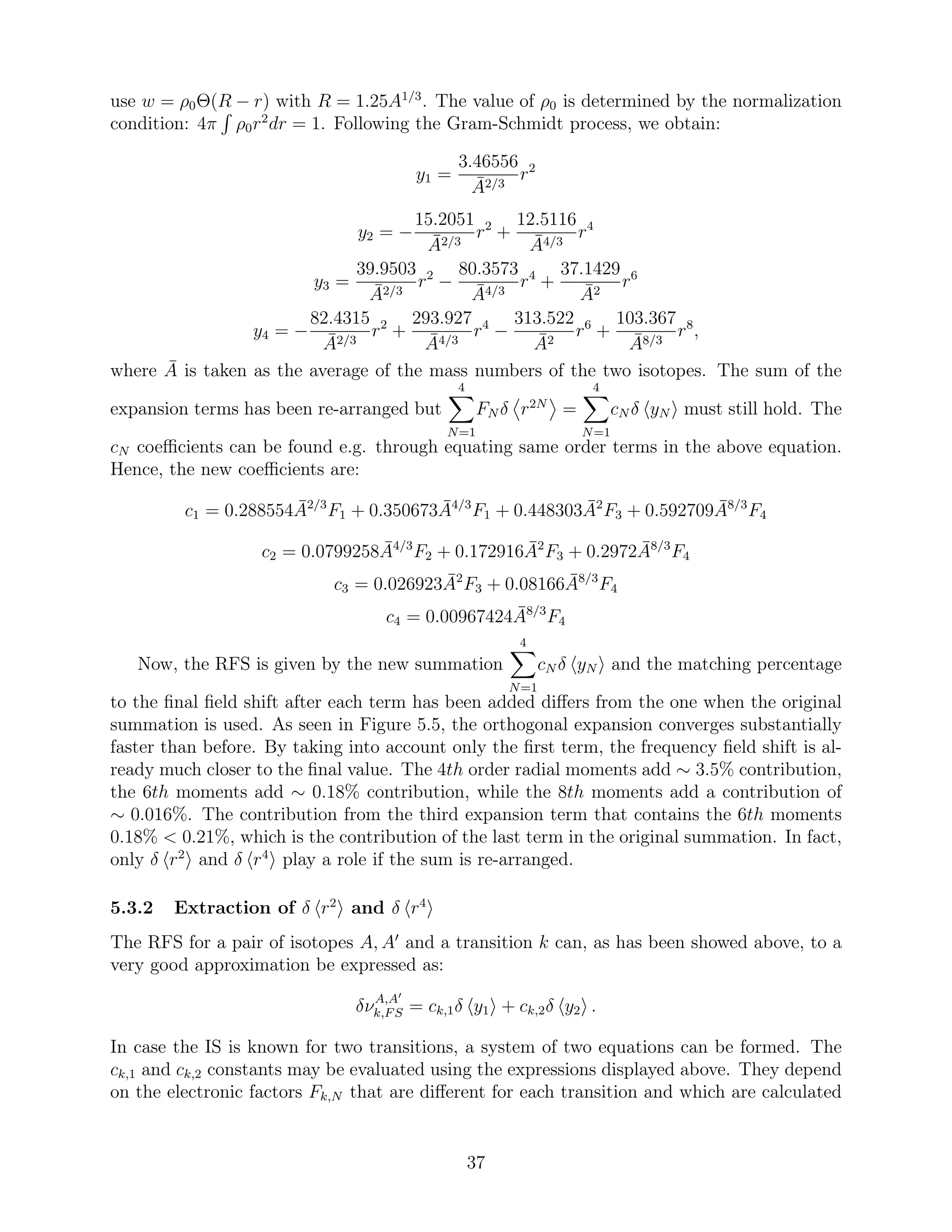
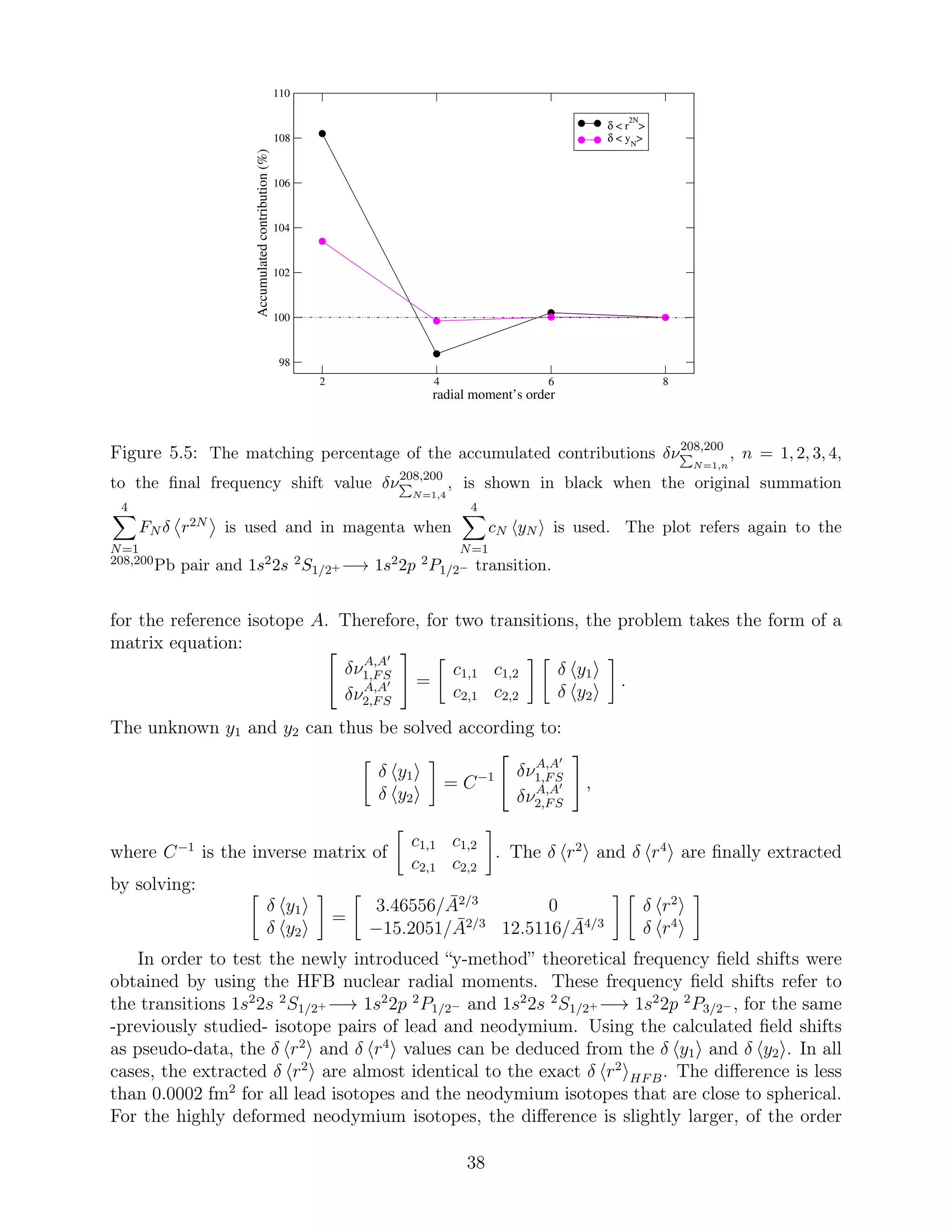
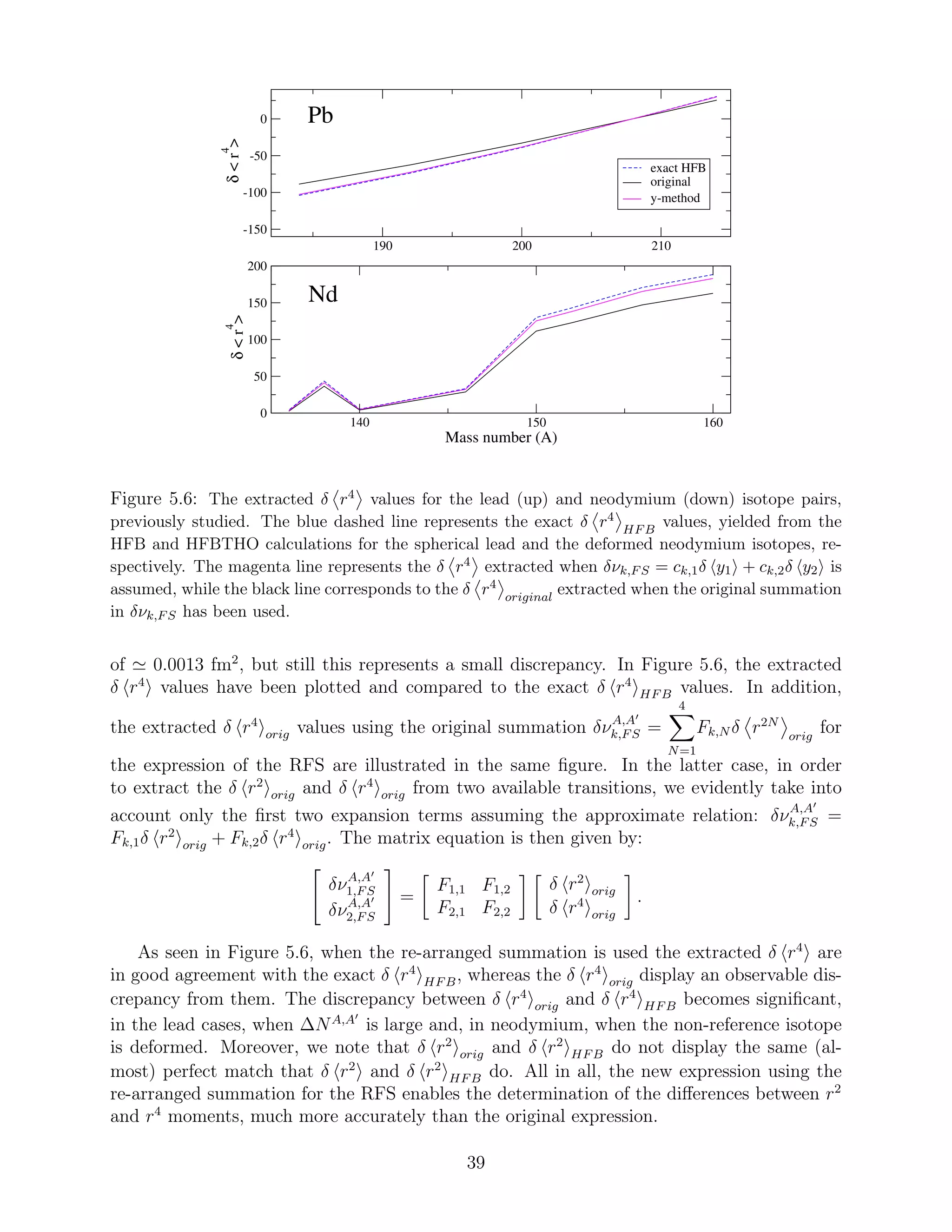

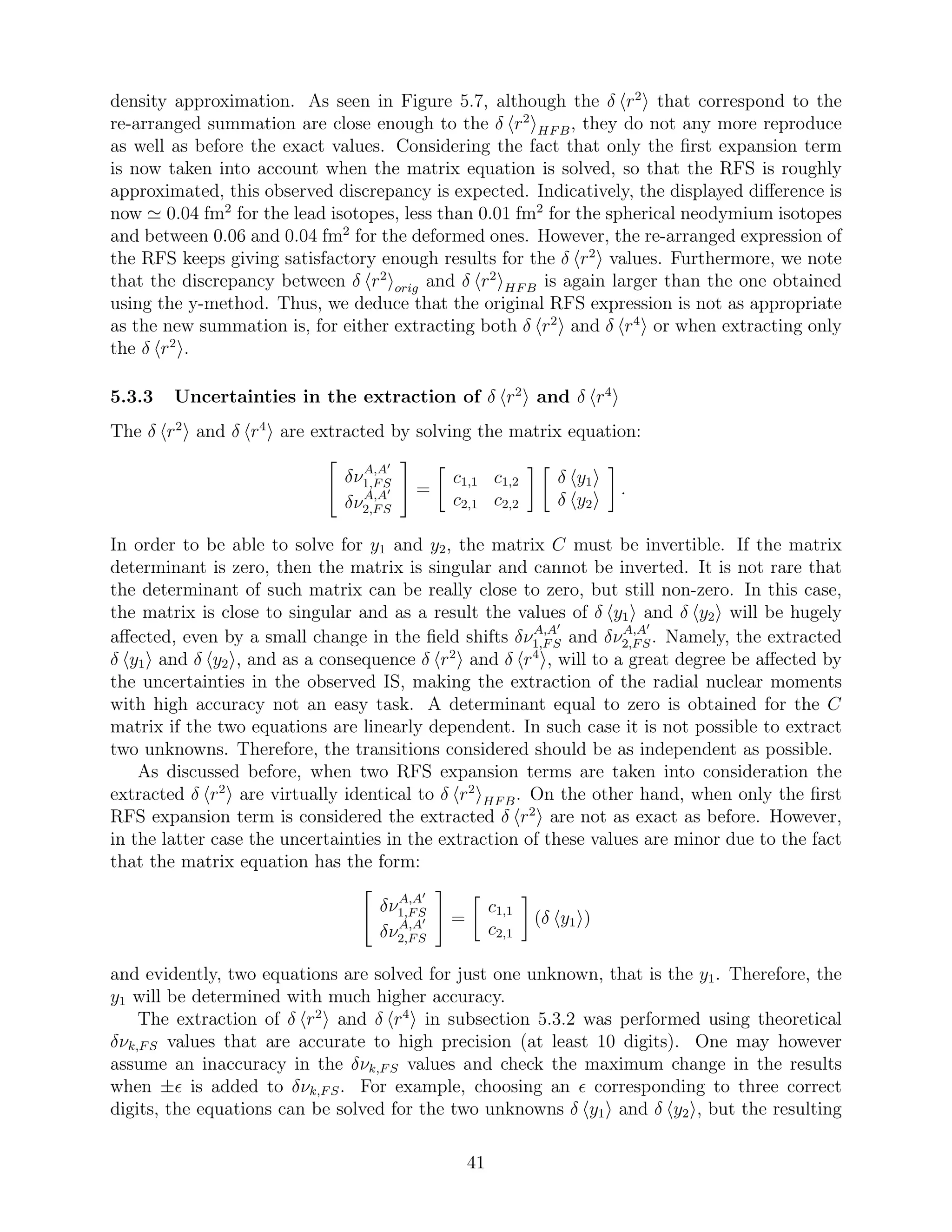
![1 2 3 4 5 6
1
10
100
δ<r
2
>[fm
2
]
1 2 3 4 5 6
number of correct digits in δνk
1
2
δ<r
2
>[fm
2
]
y-method
error width
exact HFB
current exp.methods
(b)
(a)
1%
10%
100%
Figure 5.8: The uncertainty magnitude in the extraction of the δ r2 142,150
(magenta line)
in relation to the number of correct digits in δν142,150
k , when two (a) and when only one (b)
expansion term have been considered. The dashed blue line illustrates the exact δ r2
HFB
value. The number of correct digits in the δν142,150
k measurement using the current experi-
mental methods is pointed out.
uncertainties are rather large. For the lead isotopes, the error in δ r2
is as large as half
of the magnitude of the δ r2
value, while for neodymium the error is even slightly larger
than the δ r2
value. On the contrary, when y1 is the only unknown, the uncertainties are
less than ±0.0014 fm2
and ±0.0025 fm2
for lead and neodymium, respectively. We note here
that for neodymium the larger uncertainties are due to deformation. If the non-reference
neodymium isotope is also spherical, then the uncertainty to the extraction of the δ r2
is
less than ±0.0004.
In Figures 5.8 (a) and 5.9 , the magnitude of the uncertainty in the extraction of δ r2 142,150
and δ r4 142,150
is indicatively illustrated for different number of correct digits in the δν142,150
k .
As mentioned before, the results are rather sensitive to the number of correct digits that are
available and as a consequence the scale of the error increases dramatically. For that reason,
the logarithm of the uncertainties had to be plotted and this explains the behavior of the
curve whenever the δ r2 142,150
and δ r4 142,150
take negative values. However, the magni-
tude of the errors is obvious from their positive maximum. As seen in Figure 5.8 (a), three
correct digits result in a rather large uncertainty in the determination of δ r2 142,150
, when
δ r4 142,150
is determined at the same time. As seen in Figure 5.9, the same holds for the
extracted δ r4 142,150
, which is determined with even greater uncertainty. Therefore, one can
deduce that at least five correct digits are needed in order for δ r2 142,150
and δ r4 142,150
to
be accurately calculated.
As seen in Figure 5.8 (b) in case we are willing to calculate only the δ r2 142,150
, three
correct digits in δν142,150
k provide us with highly accurate results. Provided the current ex-
42](https://image.slidesharecdn.com/f4d44770-da07-4f00-b74e-f72d1ffe325c-160216114919/75/A_Papoulia_thesis2015-43-2048.jpg)
![1 2 3 4 5 6
number of correct digits in δνk
1
10
100
1000
10000
1e+05
1e+06
δ<r
4
>[fm
4
]
exact HFB
y-method
error width
current exp. methods
2%
200%
20%
Figure 5.9: The uncertainty magnitude in the extraction of δ r4
in relation to the number
of correct digits in δν142,150
k . The dashed blue line illustrates the exact δ r2
HFB value. The
number of correct digits in the δν142,150
k measurement using the current experimental methods
is pointed out.
perimental methods, the extraction of δ r2 142,150
as the exclusive unknown may already be
performed with high precision in the sense that the experimental errors do not influence the
extracted δ r2 142,150
values. However, the extracted δ r2 142,150
still suffer from model errors
depending on our assumptions made for δ r4 142,150
, and as a result they differ from the exact
value (compare red with blue dashed line in Fig.5.8 (b)).
6 Results
The charge distributions resulting from different isotopes effect the electronic orbitals. There-
fore, analogue atomic spectral lines from these isotopes display a small shift in energy, the
so-called frequency isotope shift. Many of the atomic structure packages that are currently
available for computing atomic properties approximate the nuclear charge distributions us-
ing the Fermi model. However, it seems that the observed isotope shift is rather sensitive
to the nuclear properties. This thesis work provides a study of the effect that the realistic
nuclear charge distributions may have on the frequency isotope shifts, as well as an estimate
of whether this effect can be observed or not.
Since the realistic nuclear distributions were of major interest, it was necessary to initially
obtain the most appropriate nuclear interaction predicting the finer details of the charge
distributions. The so-called UDF1 set of Skyrme-parameters reproduces quite reliably the
experimental results, displaying, for the rms radii and the most significant moment r4
, a
mean value for the errors of the studied isotopes of the order of 1% and 6%, respectively.
The corresponding errors for the higher order moments r6
and r8
were estimated to be 11%
and 23%. A satisfactory enough theoretical representation of the higher order moments
was important at this stage, since the isotope field shifts are approximated by an expansion
43](https://image.slidesharecdn.com/f4d44770-da07-4f00-b74e-f72d1ffe325c-160216114919/75/A_Papoulia_thesis2015-44-2048.jpg)
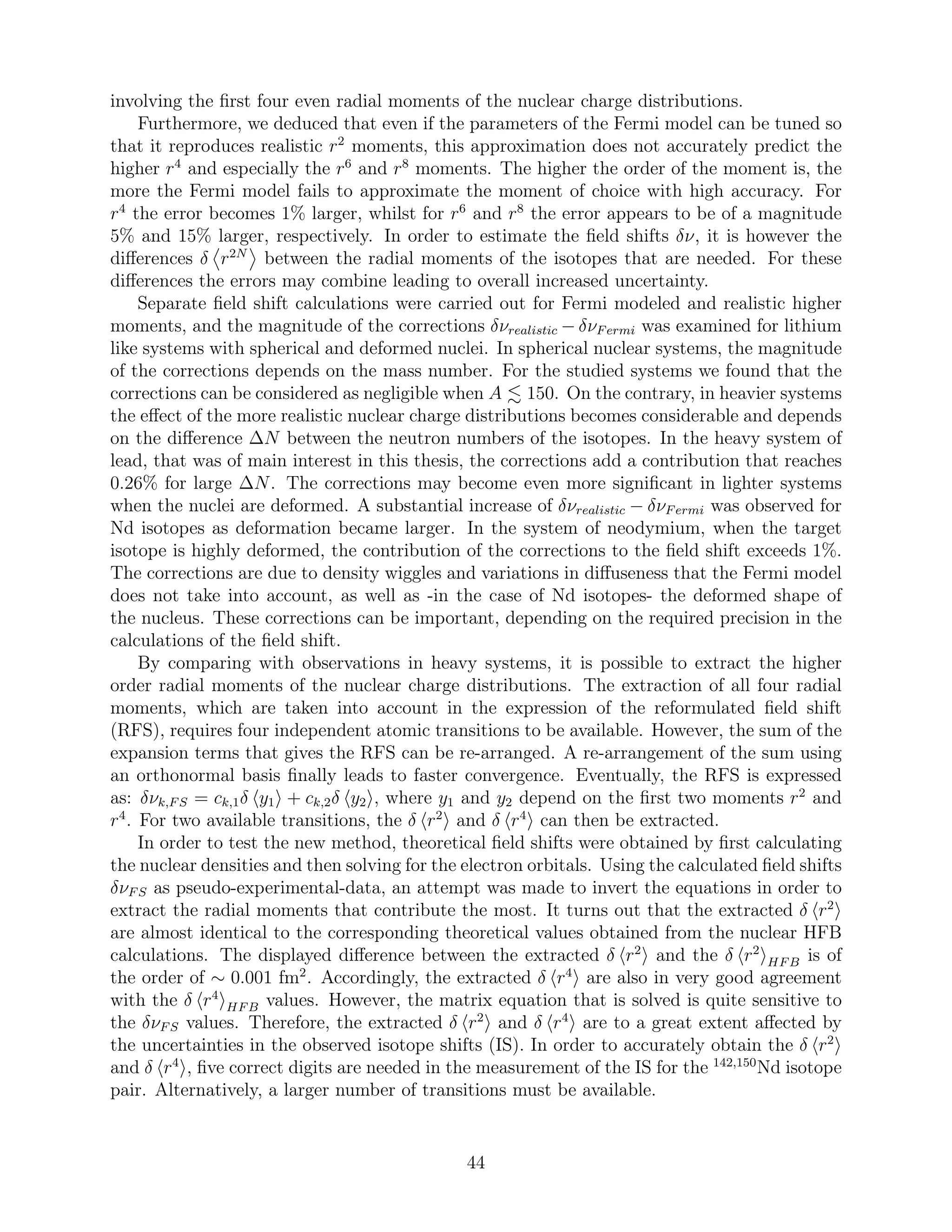

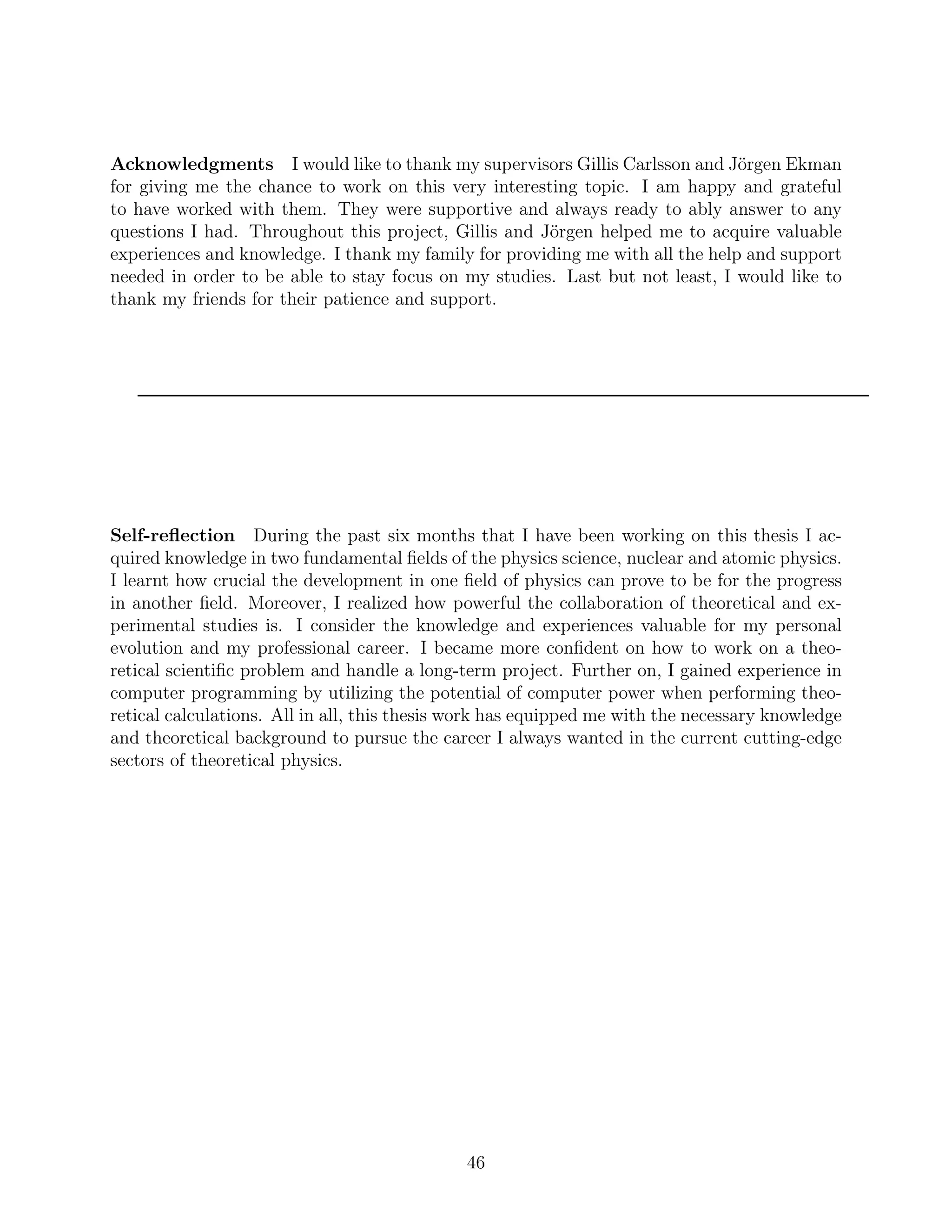
![References
[1] I. Angeli. A consistent set of nuclear rms charge radii: properties of the radius surface
r(n,z). Atomic Data and Nuclear Data Tables, 87(2):185 – 206, 2004.
[2] I. Angeli and K.P. Marinova. Table of experimental nuclear ground state charge radii:
An update. Atomic Data and Nuclear Data Tables, 99(1):69–95, 2013.
[3] F. Aryasetiawan. Course litterature:"electronic structure theory". pages 24–25, 2014.
[4] B.G.Carlsson. Course litterature: "nuclear structure theory".
[5] S A Blundell, P E G Baird, C W P Palmer, D N Stacey, and G K Woodgate. A
reformulation of the theory of field isotope shift in atoms. Journal of Physics B: Atomic
and Molecular Physics, 20(15):3663, 1987.
[6] A. Bouyssy, J.-F. Mathiot, Nguyen Van Giai, and S. Marcos. Relativistic description of
nuclear systems in the hartree-fock approximation. Phys. Rev. C, 36:380–401, 1987.
[7] B.G. Carlsson, J. Dobaczewski, J. Toivanen, and P. Veselý. Solution of self-consistent
equations for the {N3LO} nuclear energy density functional in spherical symmetry. the
program hosphe (v1.02). Computer Physics Communications, 181(9):1641–1657, 2010.
[8] P.Jönsson C.Froese Fischer, T.Brage. Computational atomic structure, an mchf ap-
proach, iop publishing, london uk (2000). page 12.
[9] Brandau et al. Isotope shift in the dielectronic recombination of three-electron A
Nd57+
.
Phys. Rev. Lett., 100(4):073201, 2008.
[10] J. Ekman et al. To be published in Computer Physics Communications.
[11] P. Jönsson, G. Gaigalas, J. Bieroń, C. Froese Fischer, and I.P. Grant. New version:
Grasp2k relativistic atomic structure package. Computer Physics Communications,
184(9):2197–2203, 2013.
[12] C. Nazé, E. Gaidamauskas, G. Gaigalas, M. Godefroid, and P. Jönsson. ris3: A pro-
gram for relativistic isotope shift calculations. Computer Physics Communications,
184(9):2187 – 2196, 2013.
[13] S.G. Nilsson and I. Ragnarsson. Shapes and shells in nuclear structure,cambridge uni-
versity press, cambridge (1995). page 300.
[14] C W P Palmer. Reformulation of the theory of the mass shift. Journal of Physics B:
Atomic and Molecular Physics, 20(22):5987, 1987.
[15] Randolf Pohl, Ronald Gilman, Gerald A. Miller, and Krzysztof Pachucki. Muonic hy-
drogen and the proton radius puzzle. Annual Review of Nuclear and Particle Science,
63(1):175–204, 2013.
[16] P. Ring and P. Schuck. The nuclear many-body problem, 1st ed. springer-verlag, new
york, (1980). pages 217–218.
47](https://image.slidesharecdn.com/f4d44770-da07-4f00-b74e-f72d1ffe325c-160216114919/75/A_Papoulia_thesis2015-48-2048.jpg)
![[17] P. Ring and P. Schuck. The nuclear many-body problem, 1st ed. springer-verlag, new
york, (1980). pages 150–153.
[18] P. Ring and P. Schuck. The nuclear many-body problem, 1st ed. springer-verlag, new
york, (1980). pages 175–176.
[19] R. Rosenfelder. Coulomb corrections to elastic electron–proton scattering and the proton
charge radius. Physics Letters B, 479(4):381 – 386, 2000.
[20] E. C. Seltzer. k x-ray isotope shifts. Phys. Rev., 188:1916–1919, 1969.
[21] V M Shabaev and A N Artemyev. Relativistic nuclear recoil corrections to the energy
levels of multicharged ions. Journal of Physics B: Atomic, Molecular and Optical Physics,
27(7):1307, 1994.
[22] M.V. Stoitsov, N. Schunck, M. Kortelainen, N. Michel, H. Nam, et al. Axially deformed
solution of the skyrme-h-f-b equations using the transformed harmonic oscillator basis
(ii) hfbtho v2.00c:a new version of the program. Comput.Phys.Commun., 184:1592–1604,
2013.
[23] J. Suhonen. From nucleons to nucleus, springer-verlag, berlin heidelberg (2007). pages
63–86.
[24] Shabaev V.M. Mass corrections in a strong nuclear field. Theoretical and Mathematical
Physics, 63(3):588–596, 1985.
[25] H. De Vries, C.W. De Jager, and C. De Vries. Nuclear charge-density-distribution
parameters from elastic electron scattering. Atomic Data and Nuclear Data Tables,
36(3):495 – 536, 1987.
48](https://image.slidesharecdn.com/f4d44770-da07-4f00-b74e-f72d1ffe325c-160216114919/75/A_Papoulia_thesis2015-49-2048.jpg)